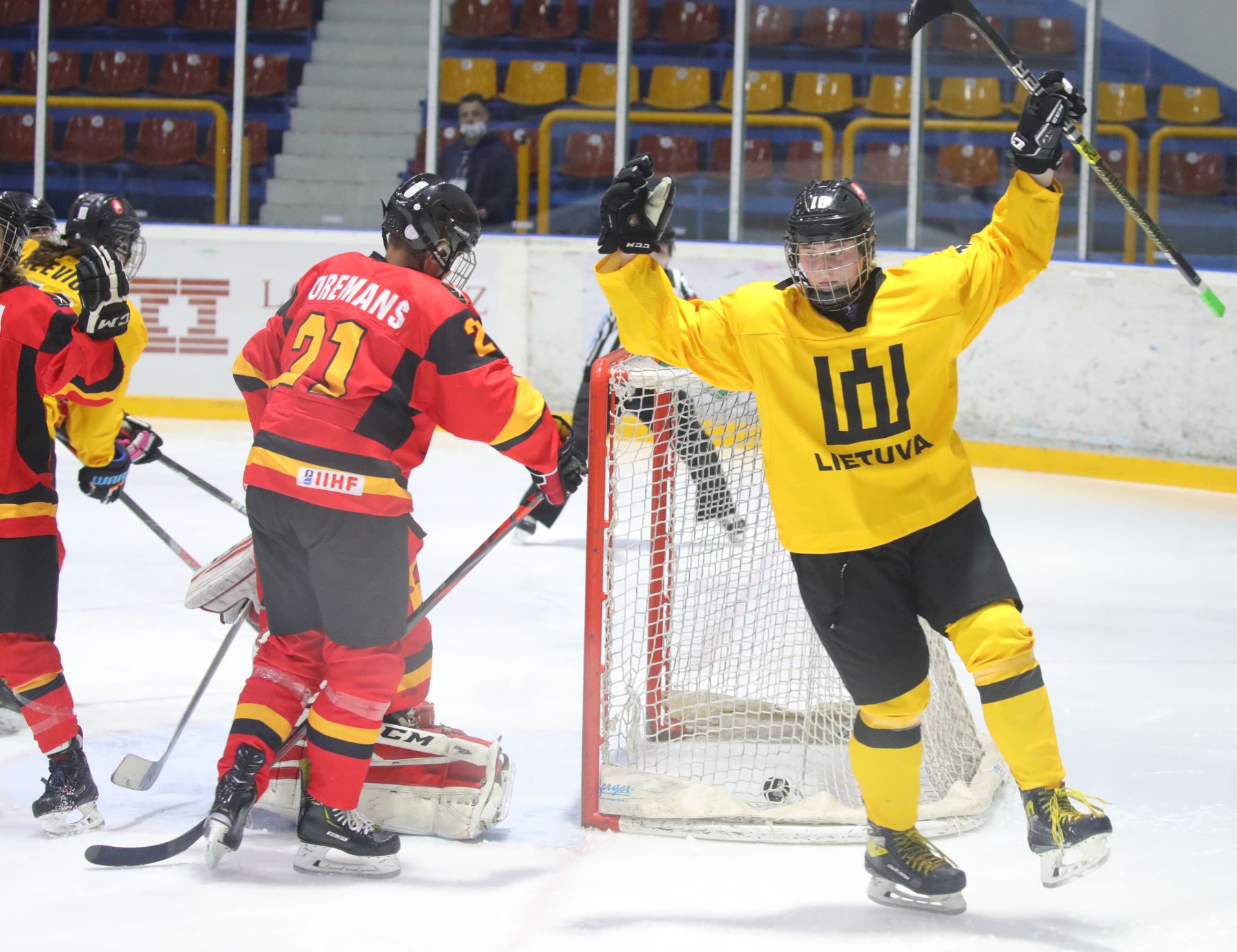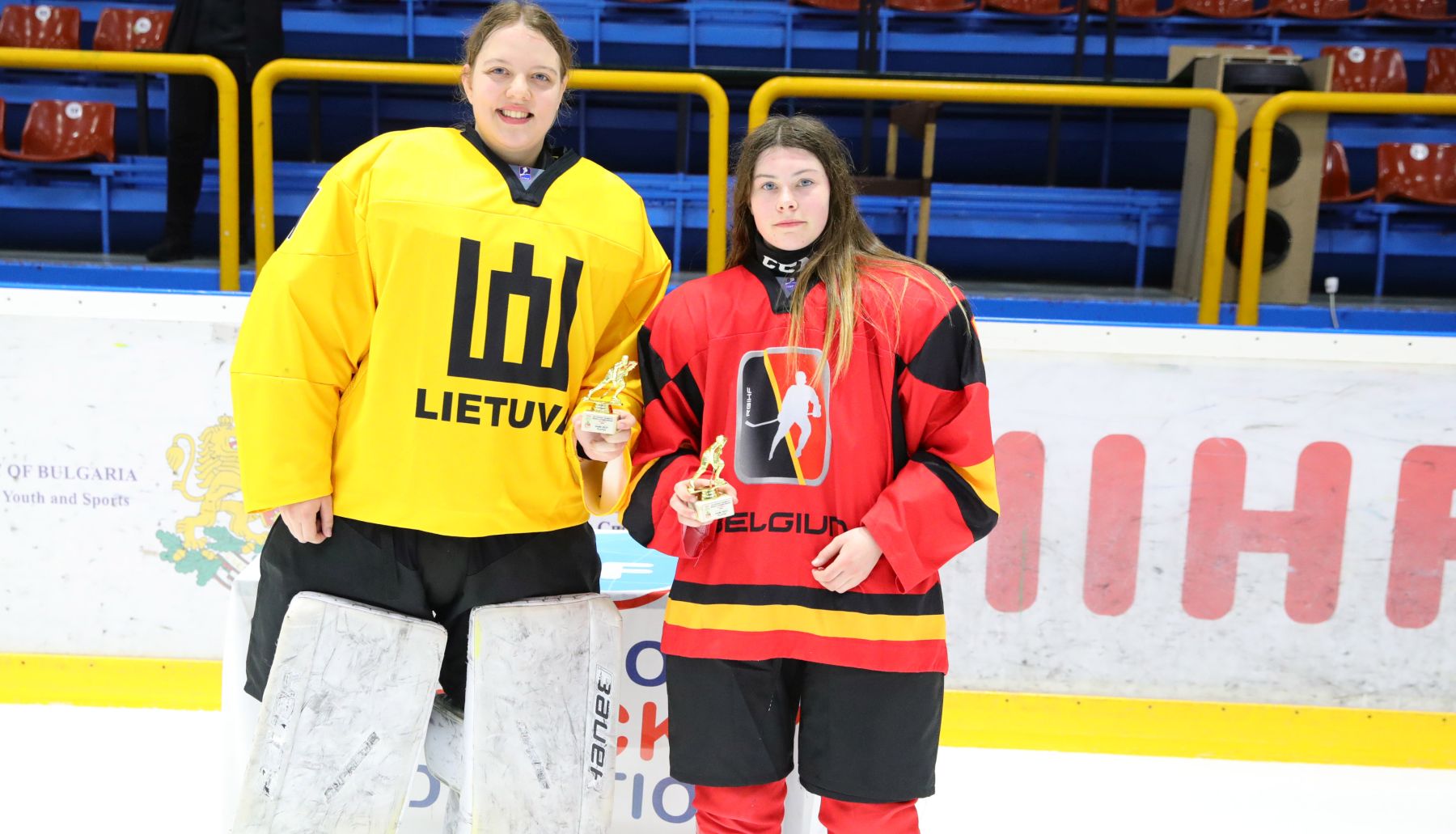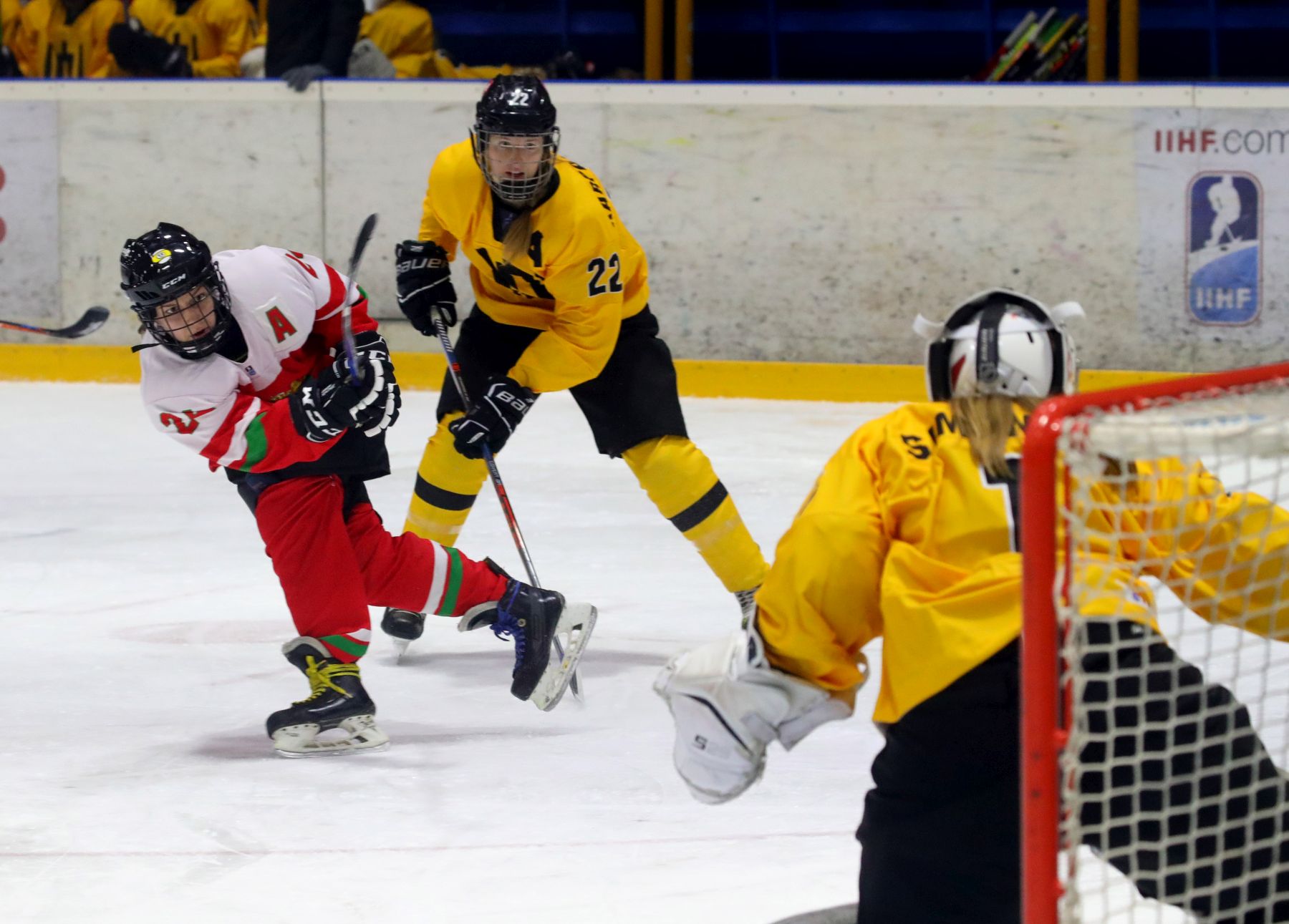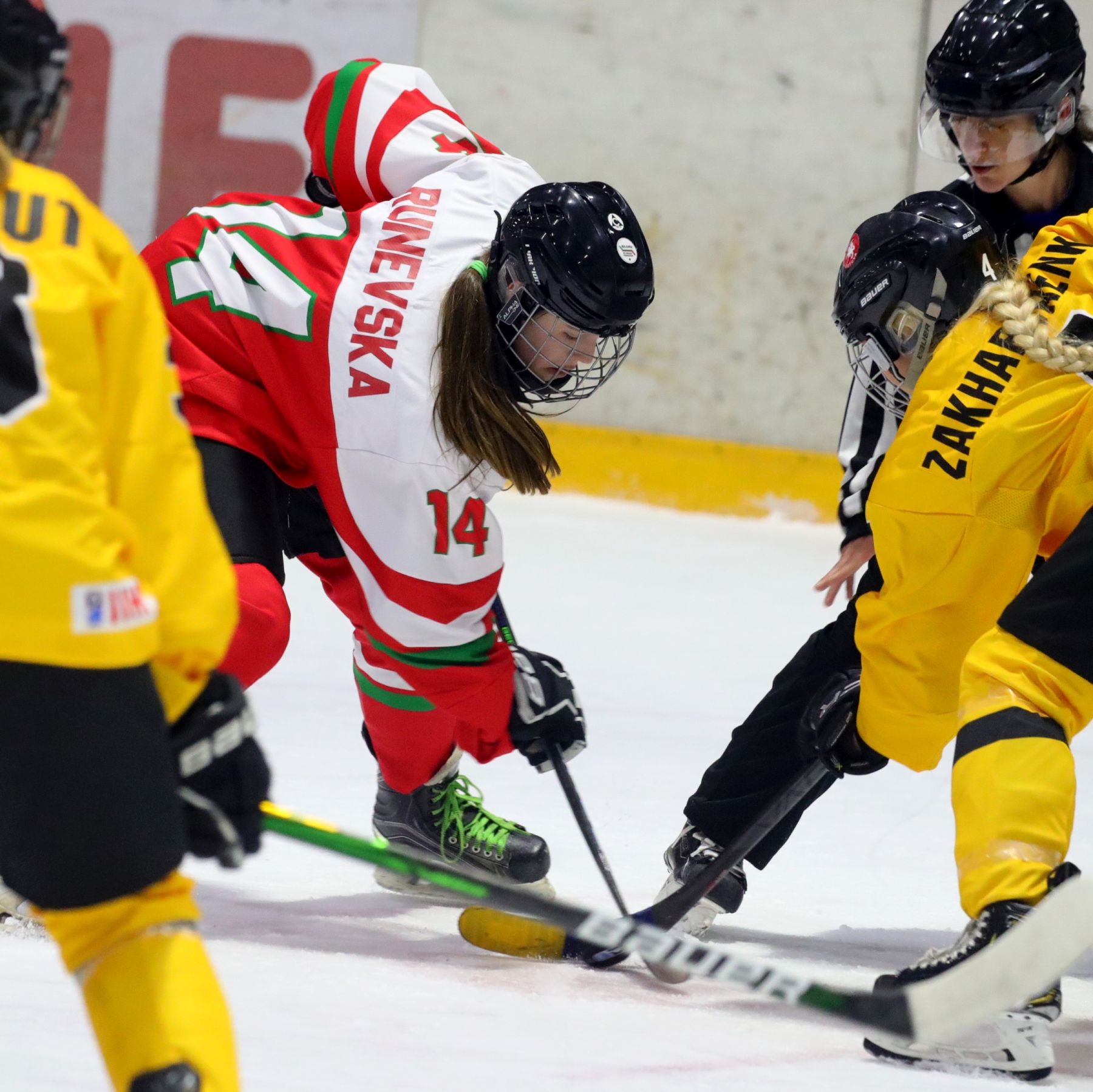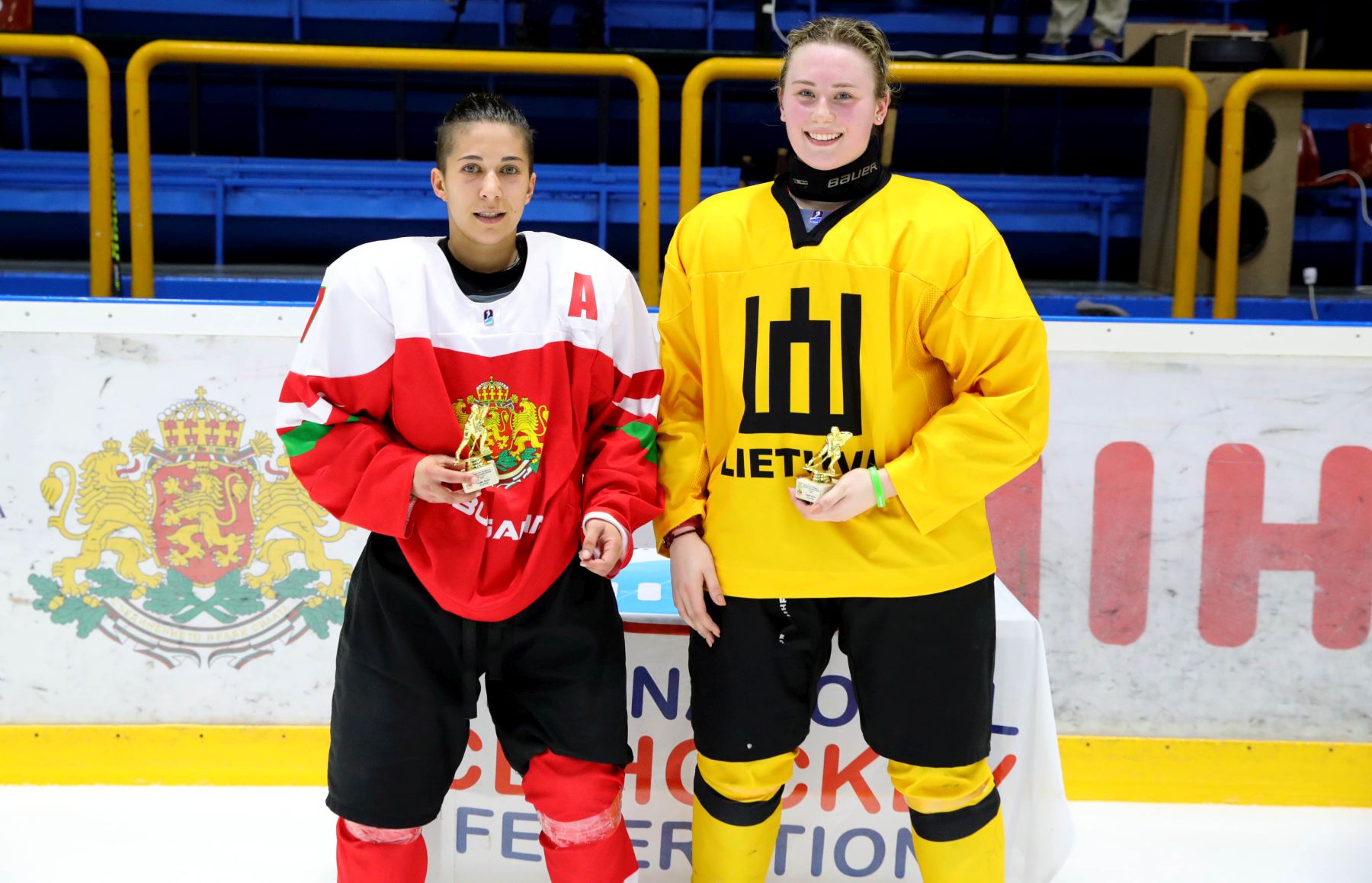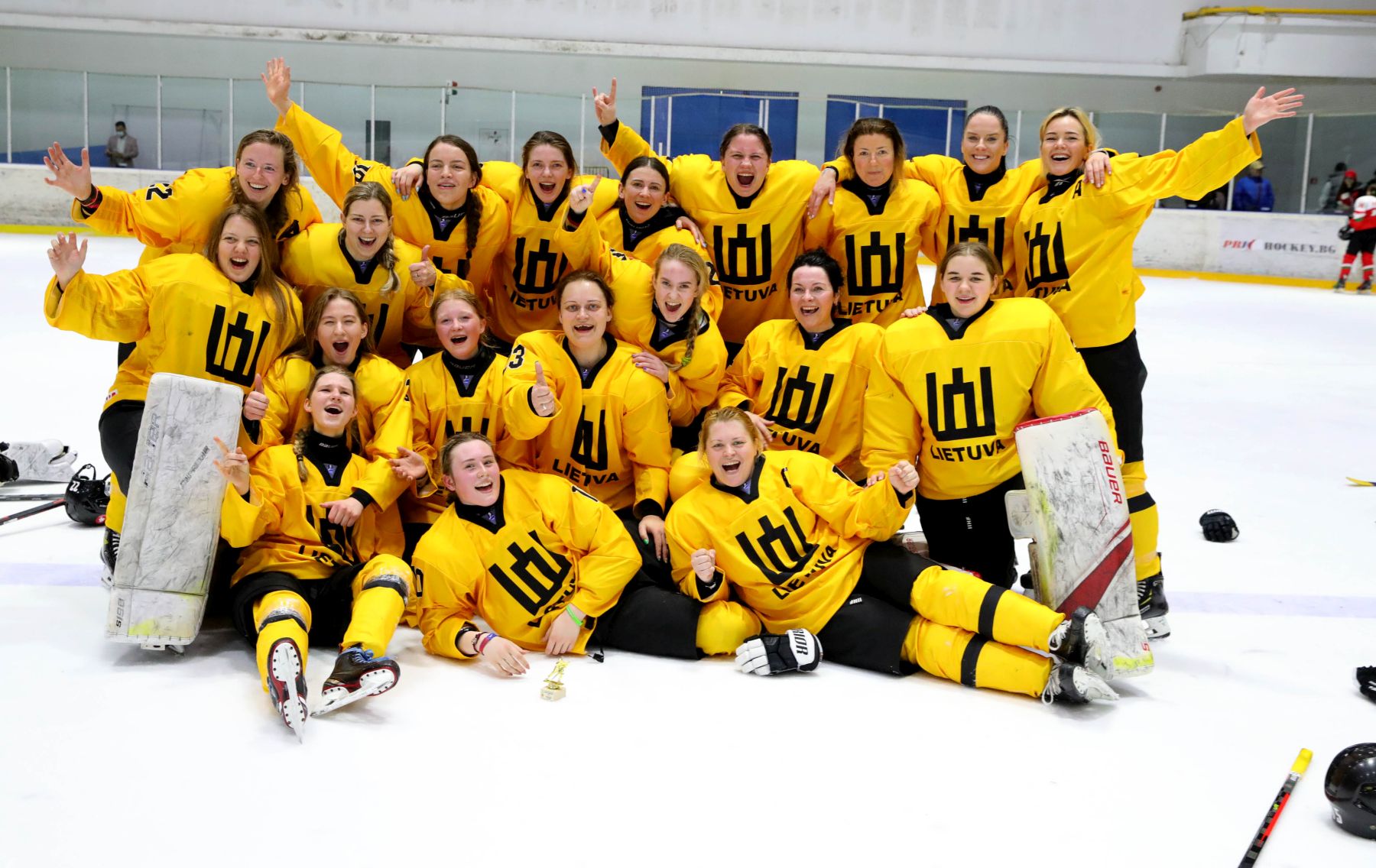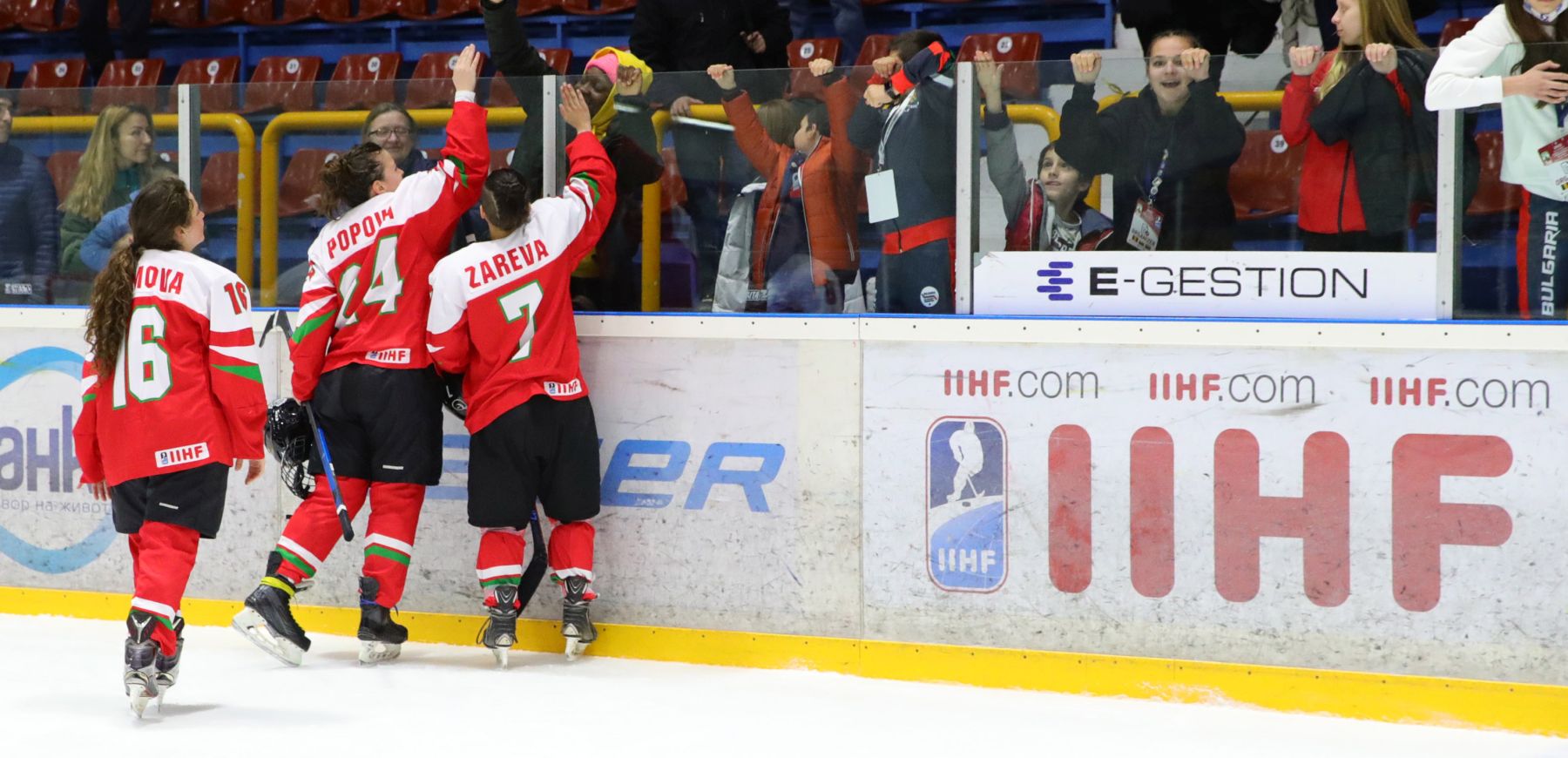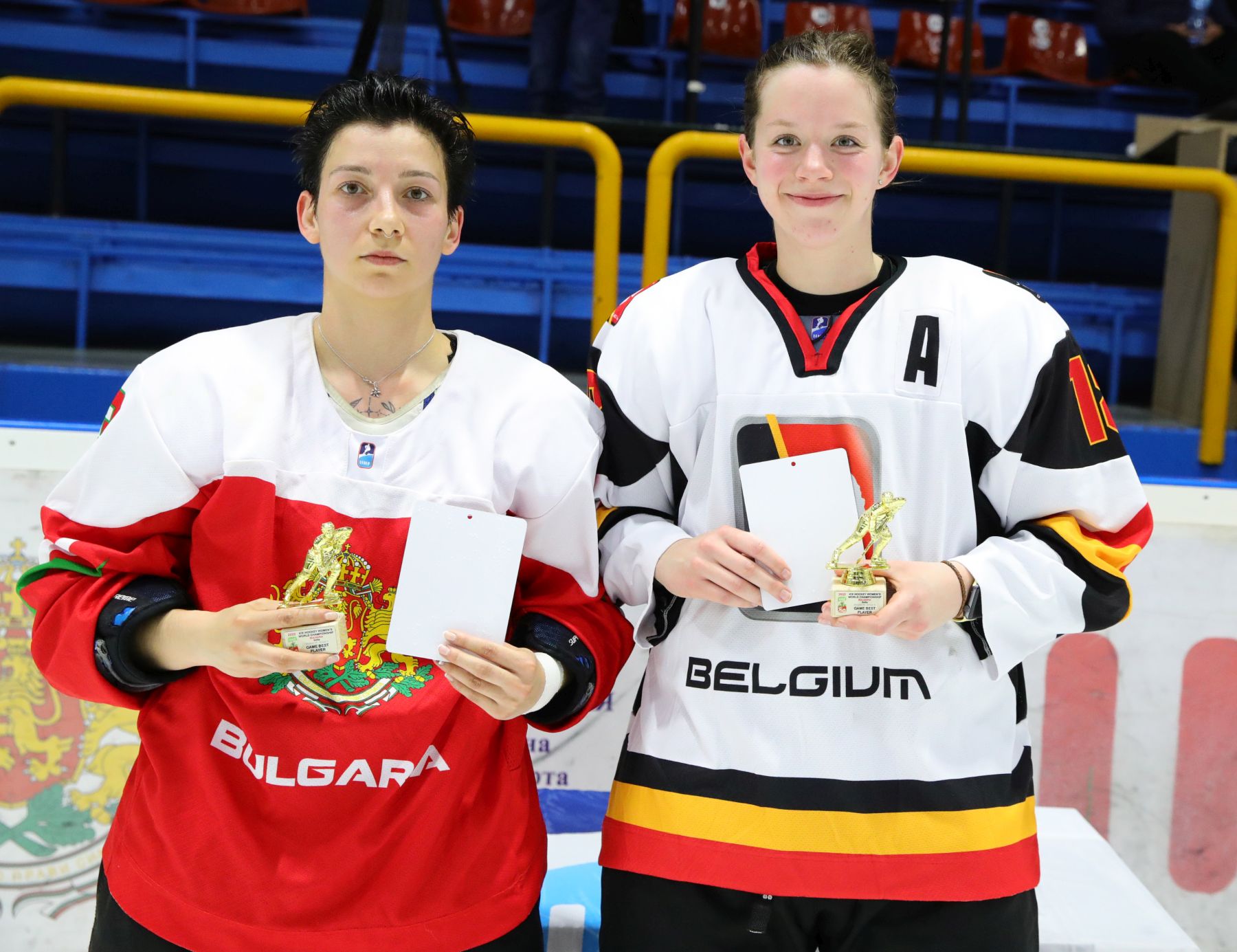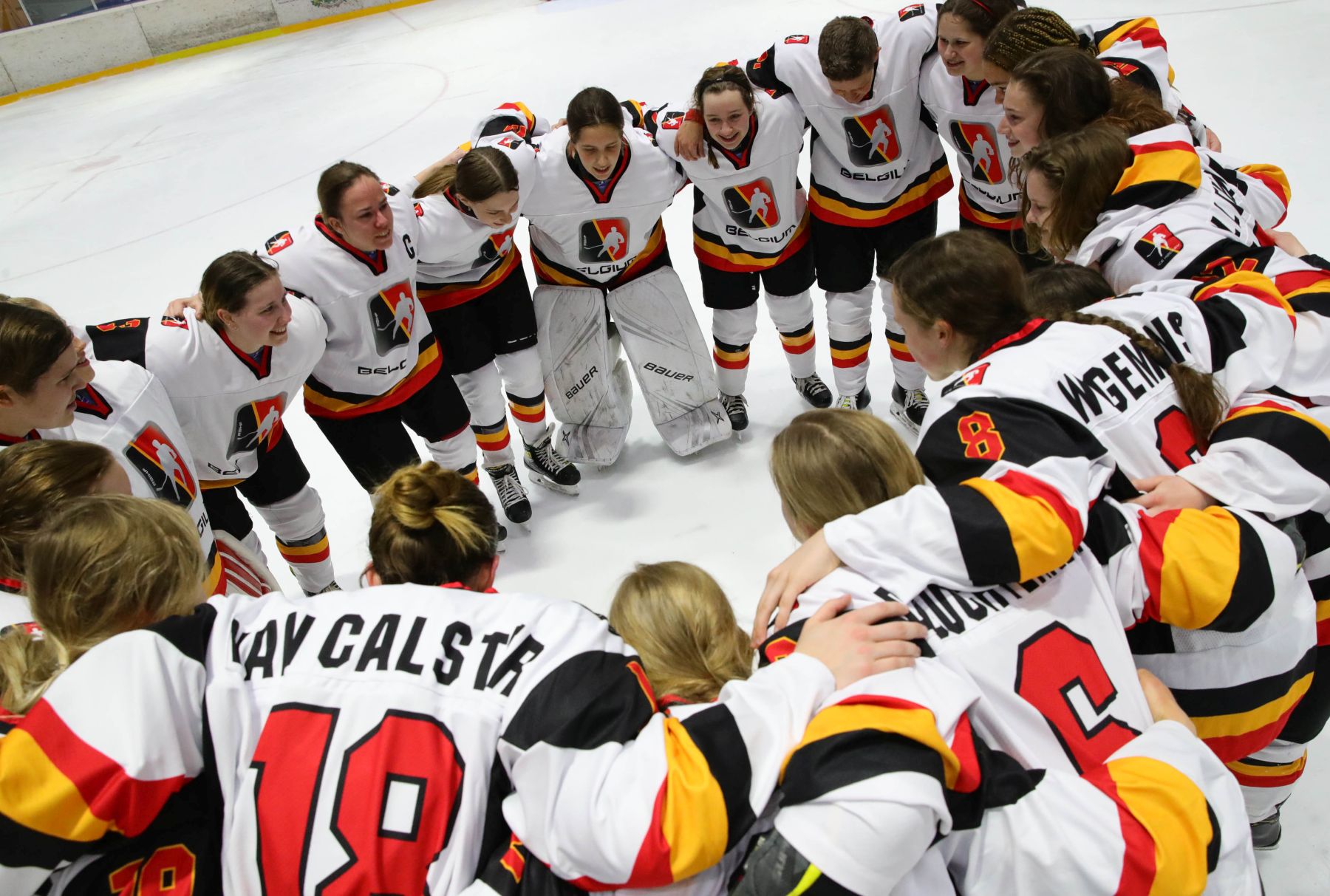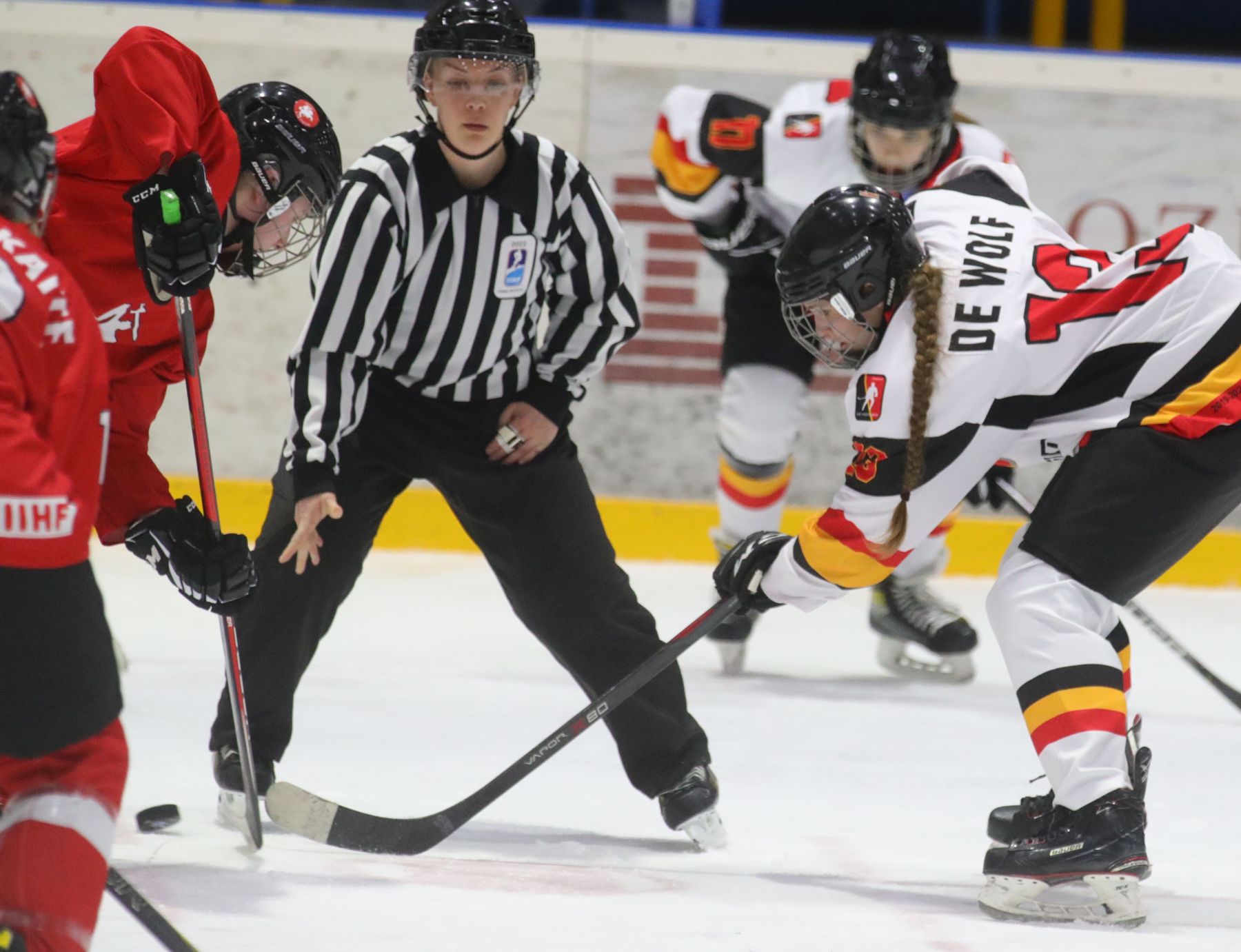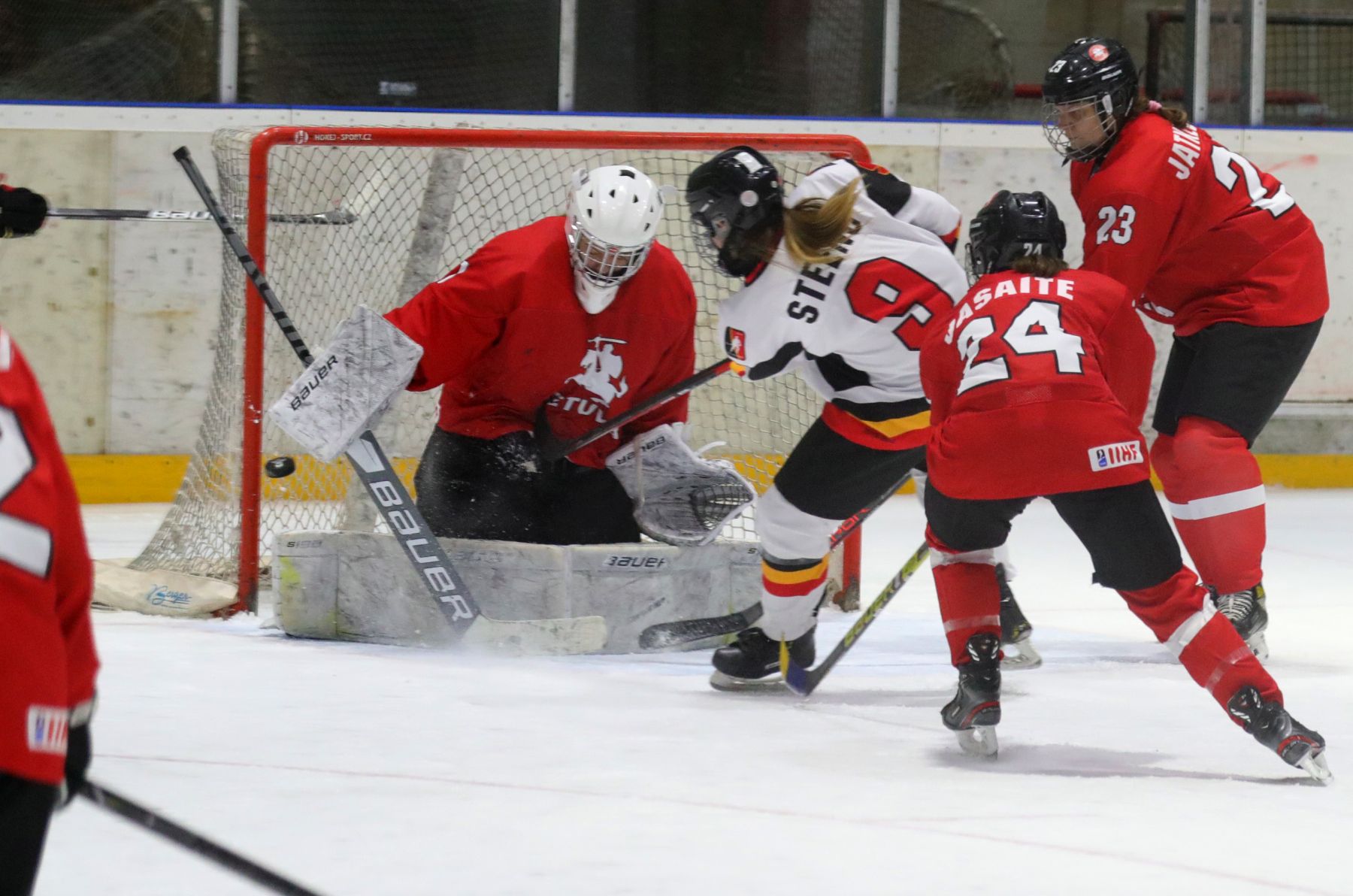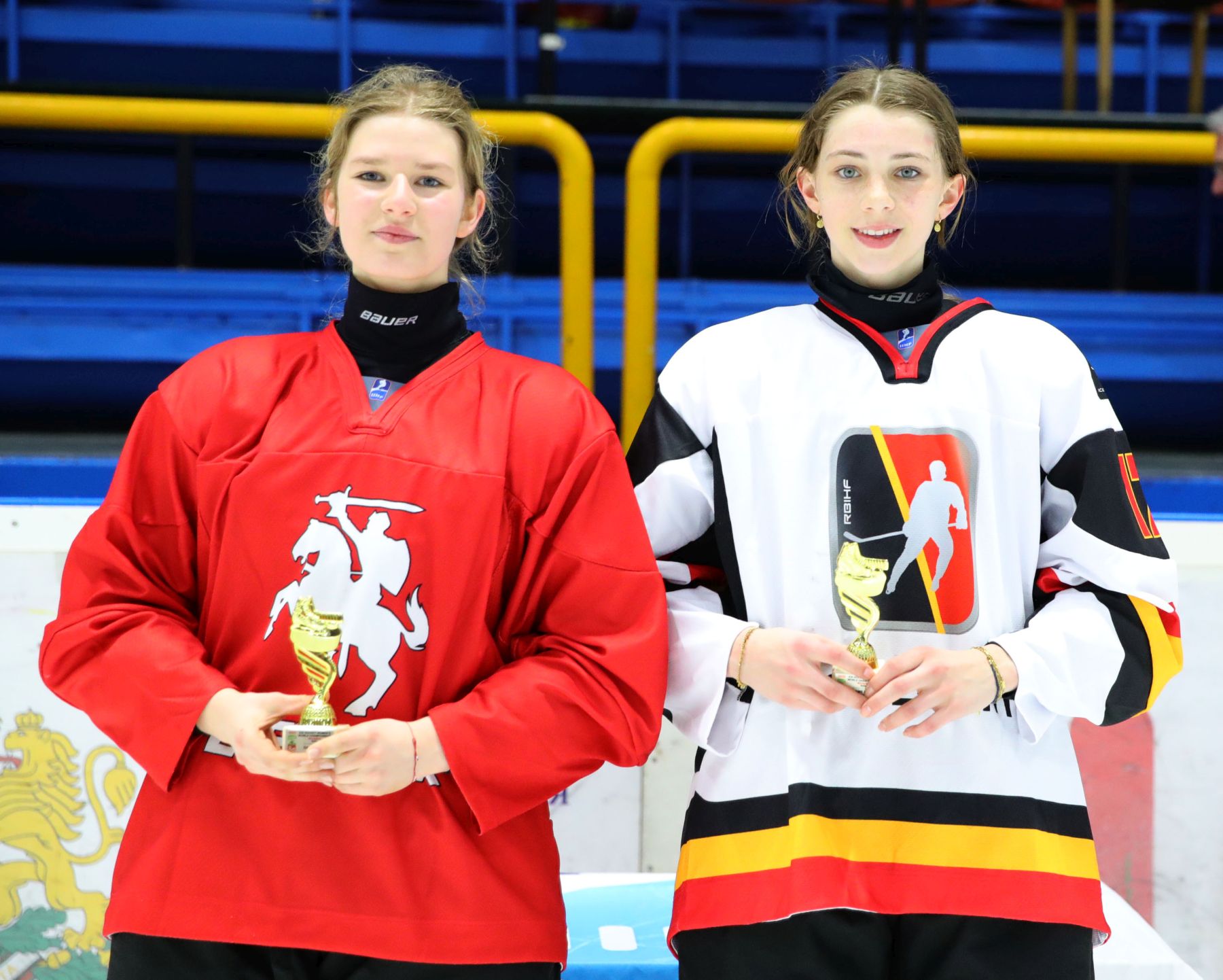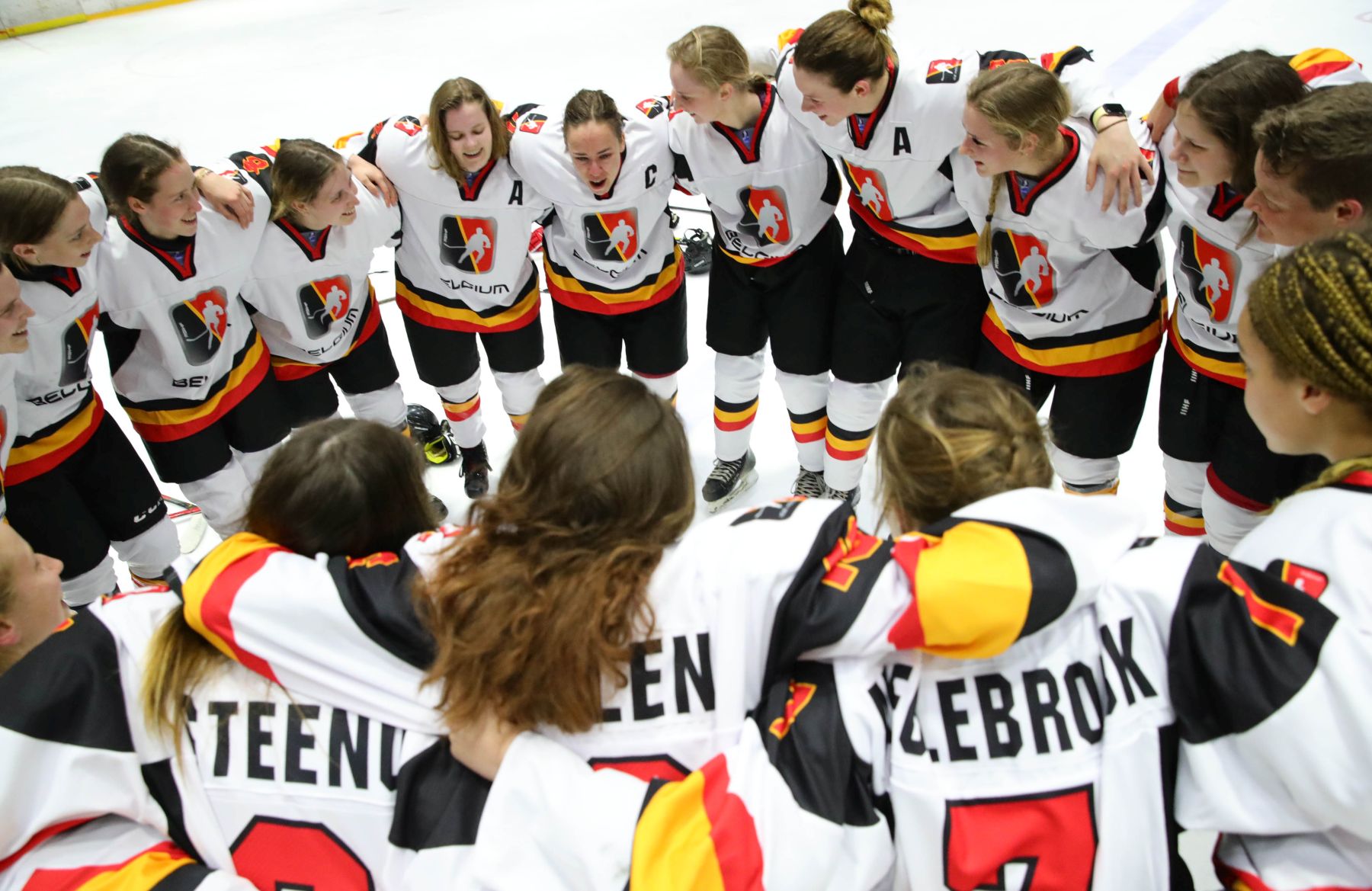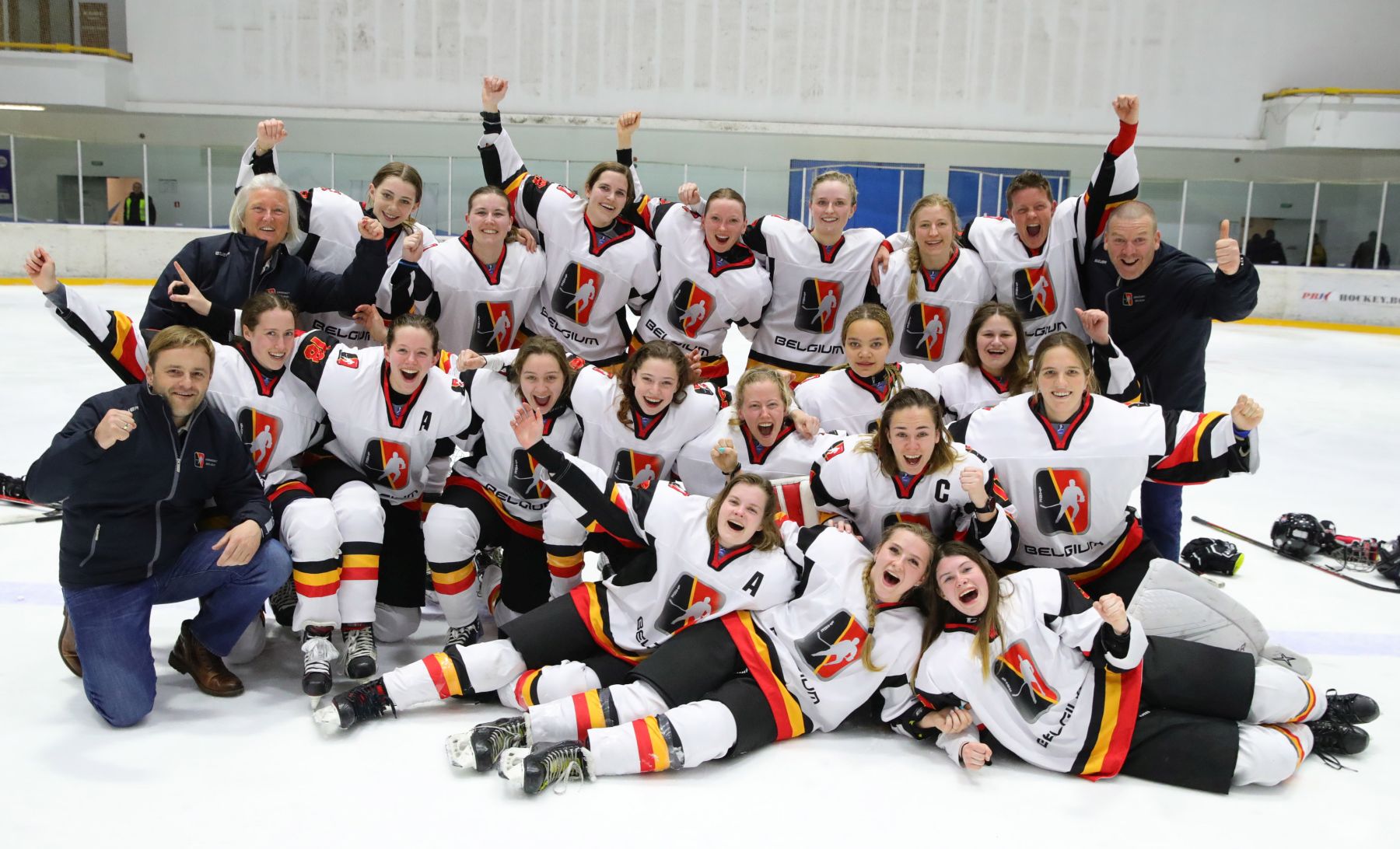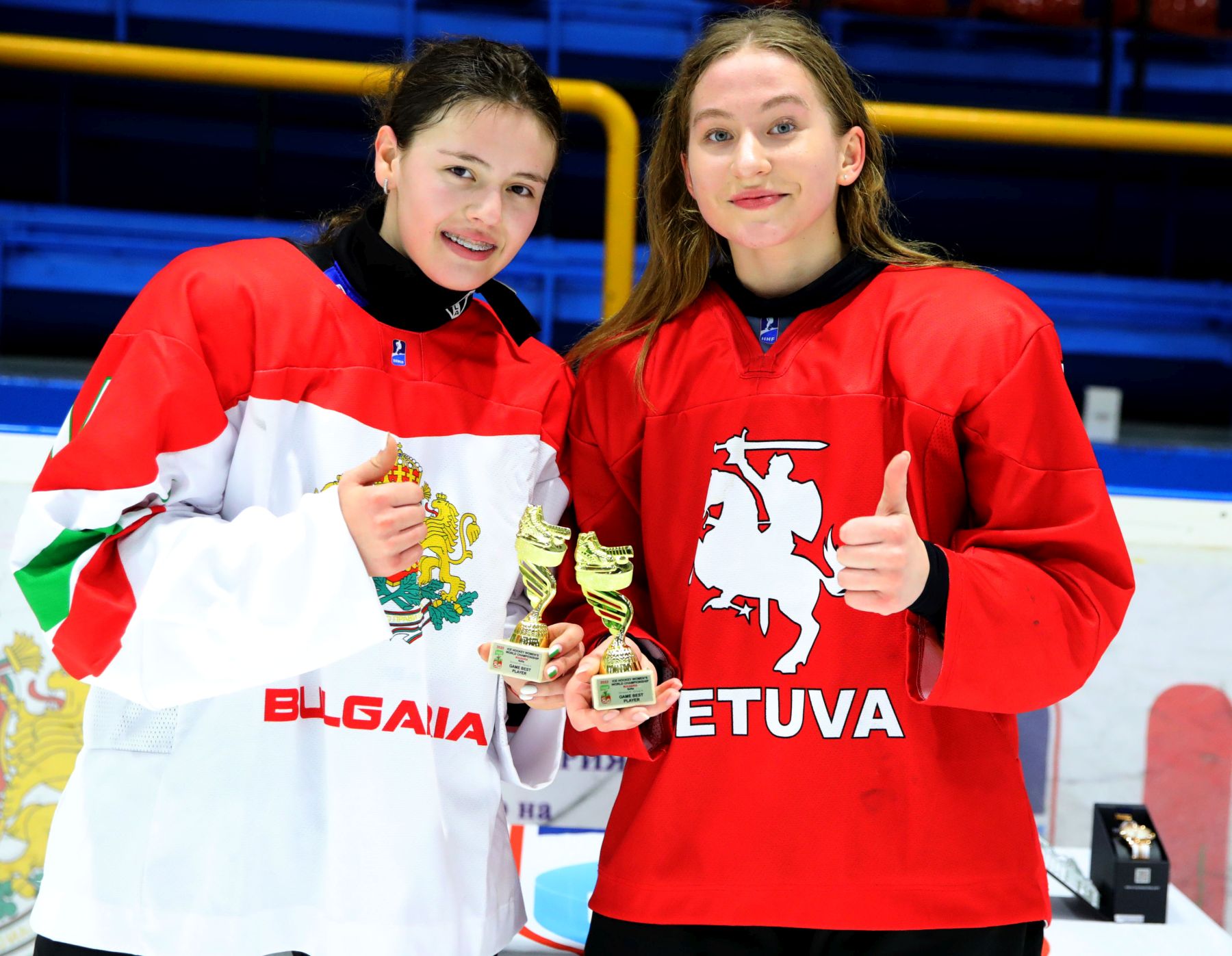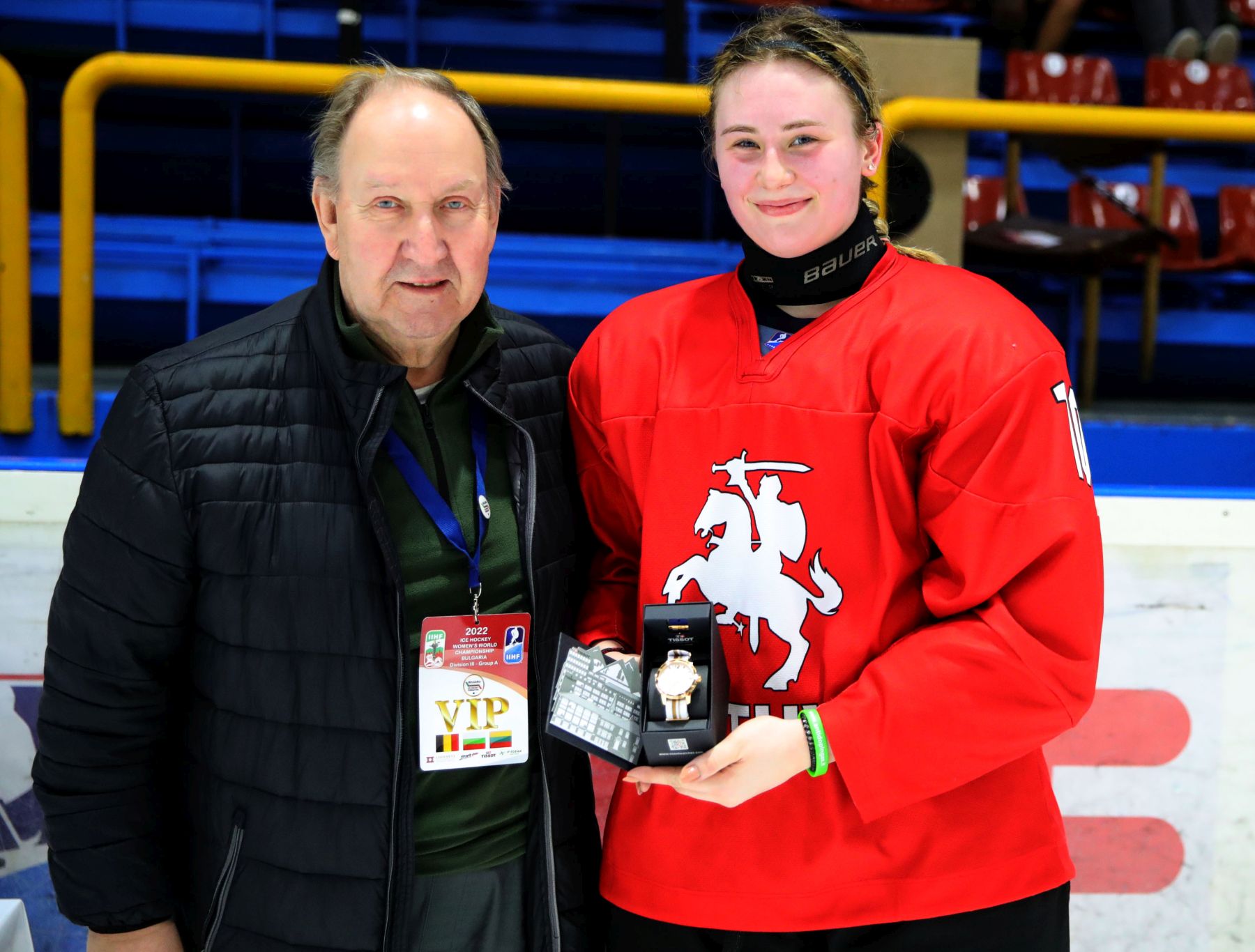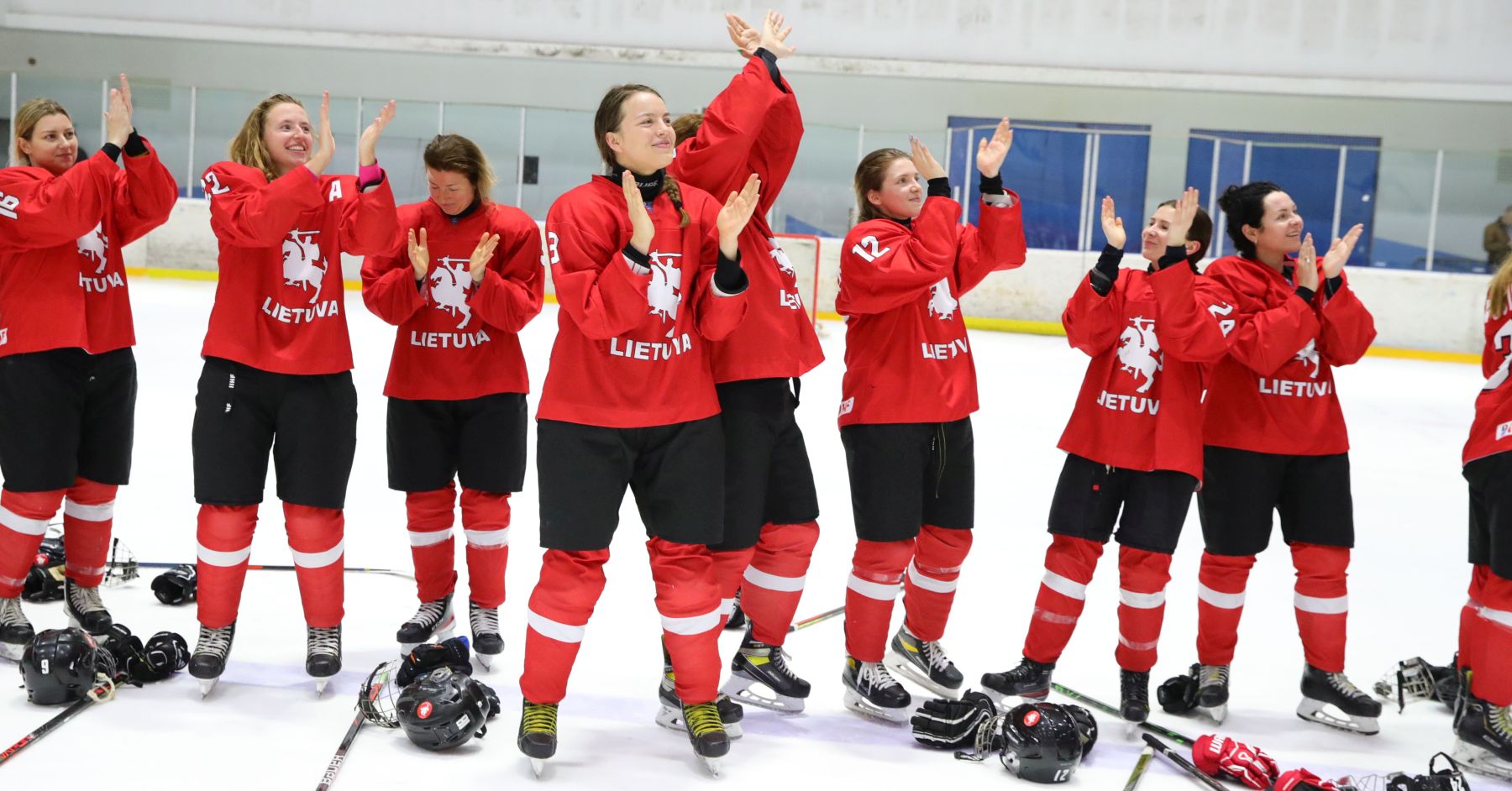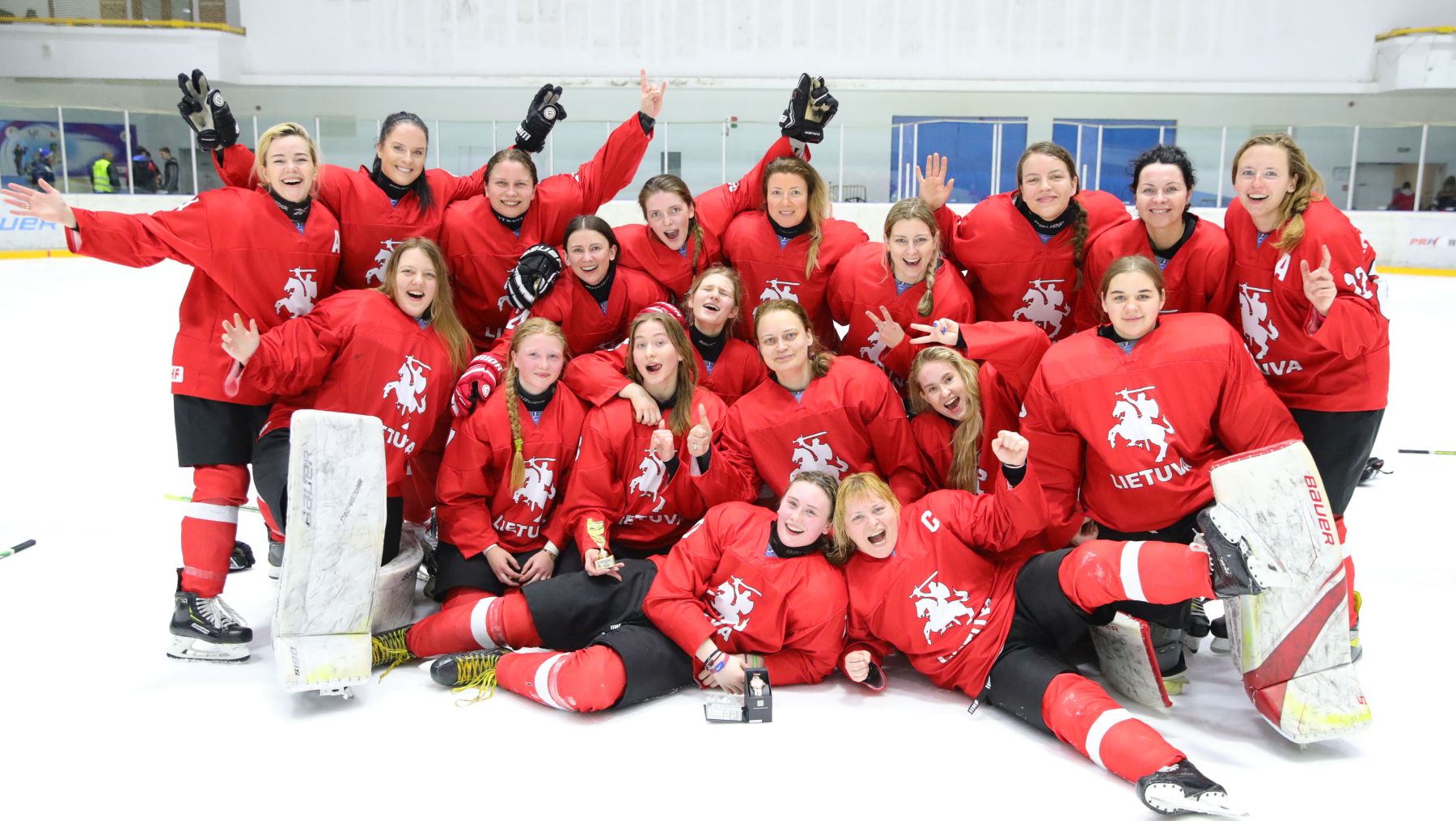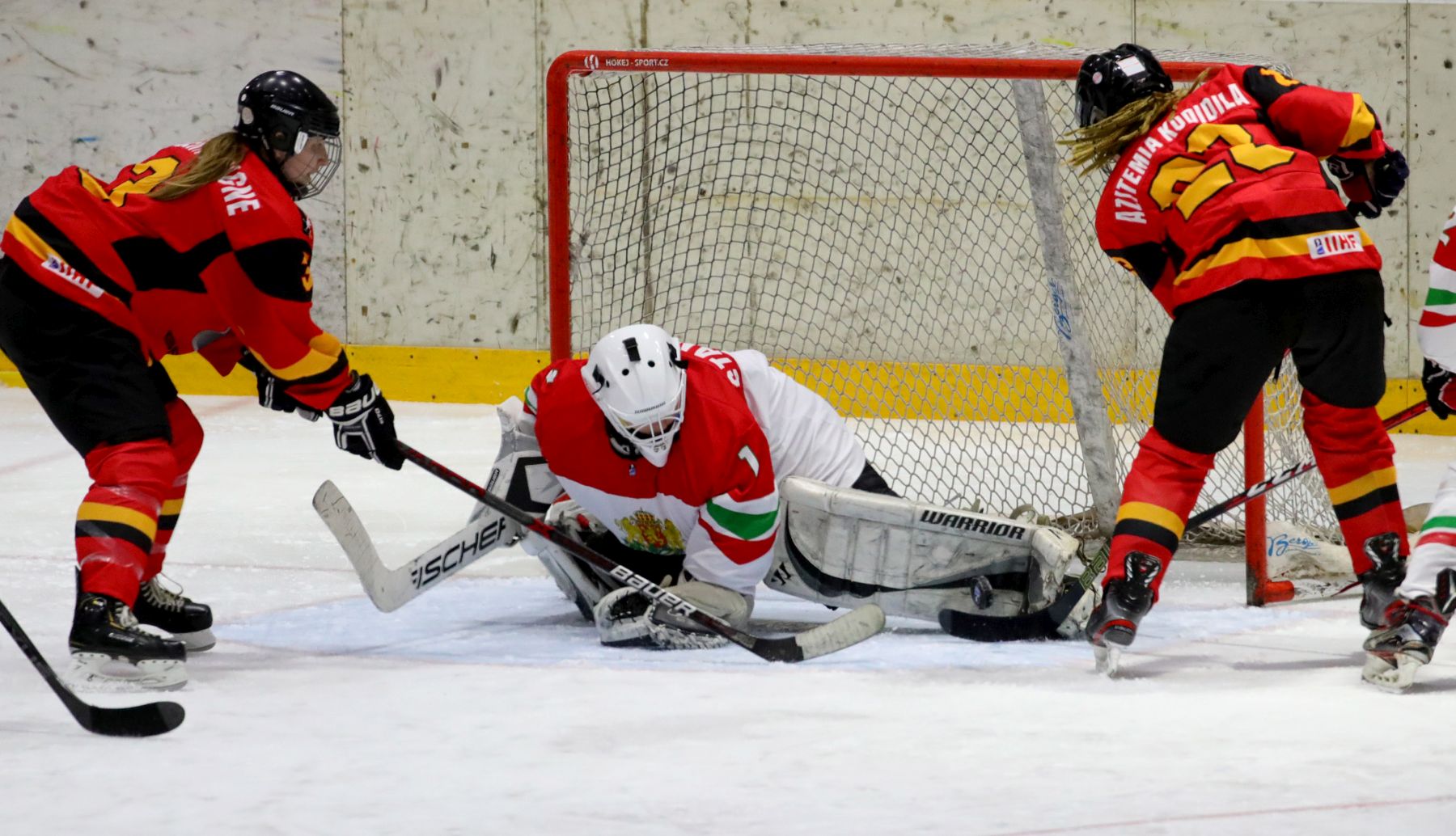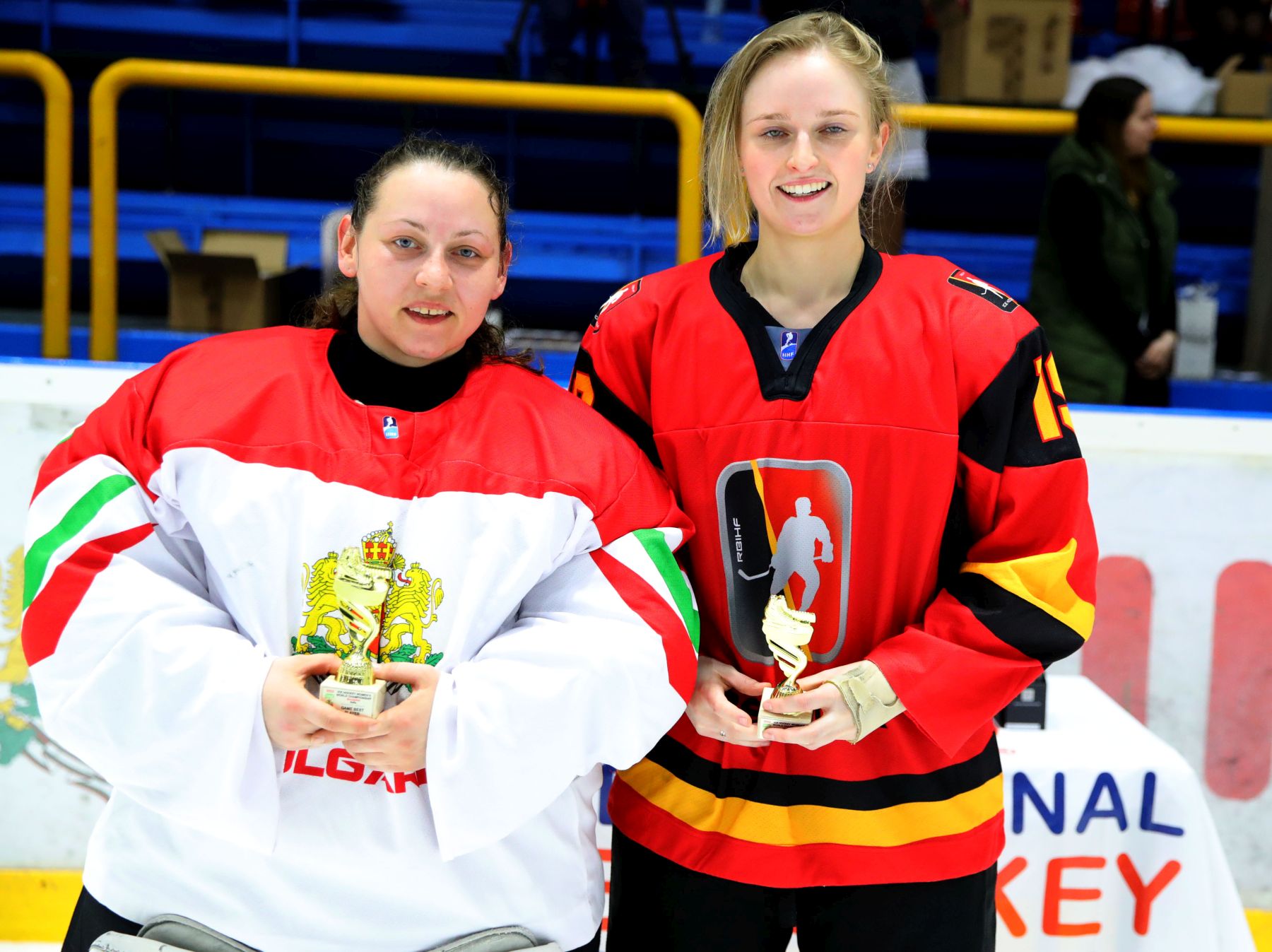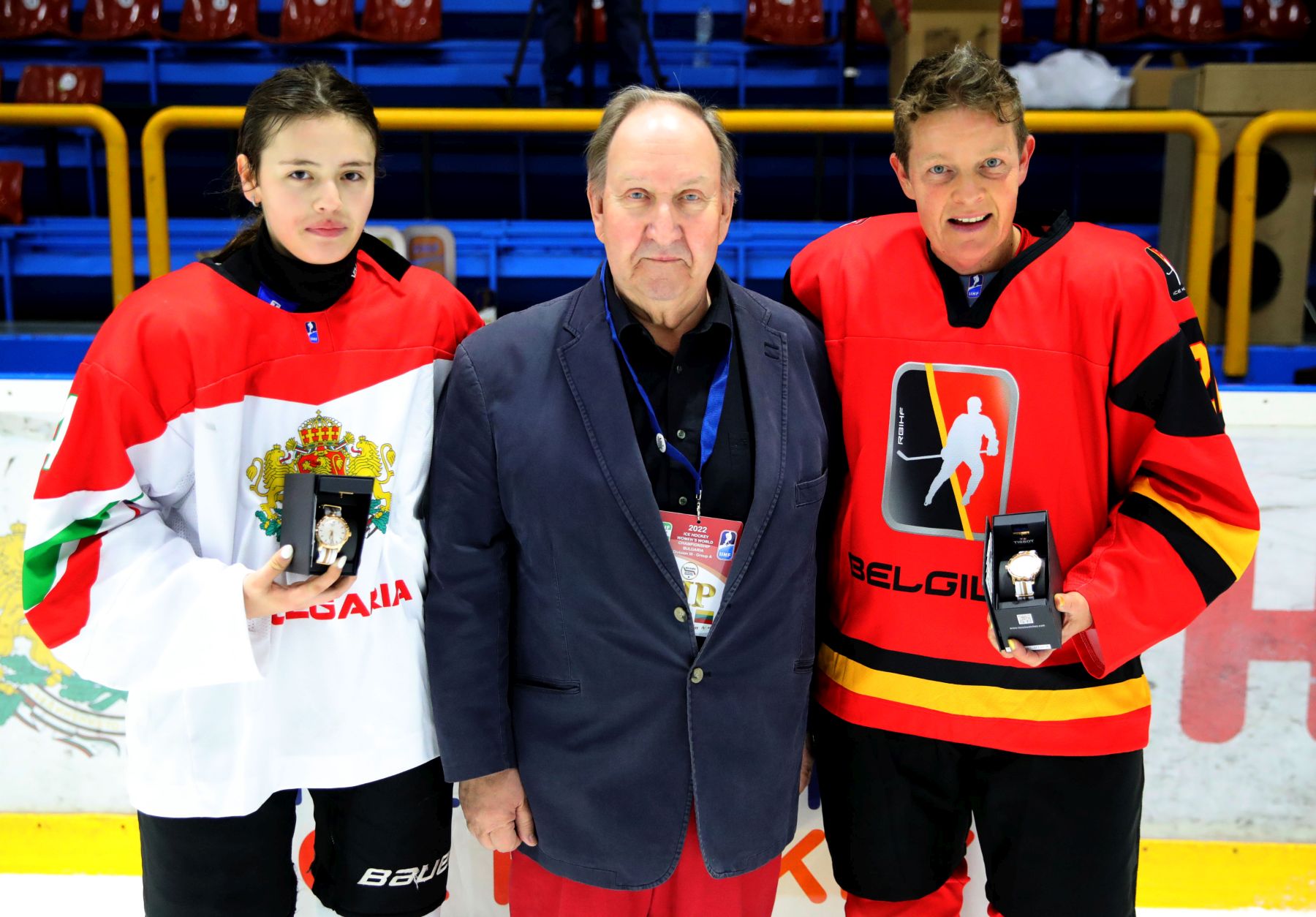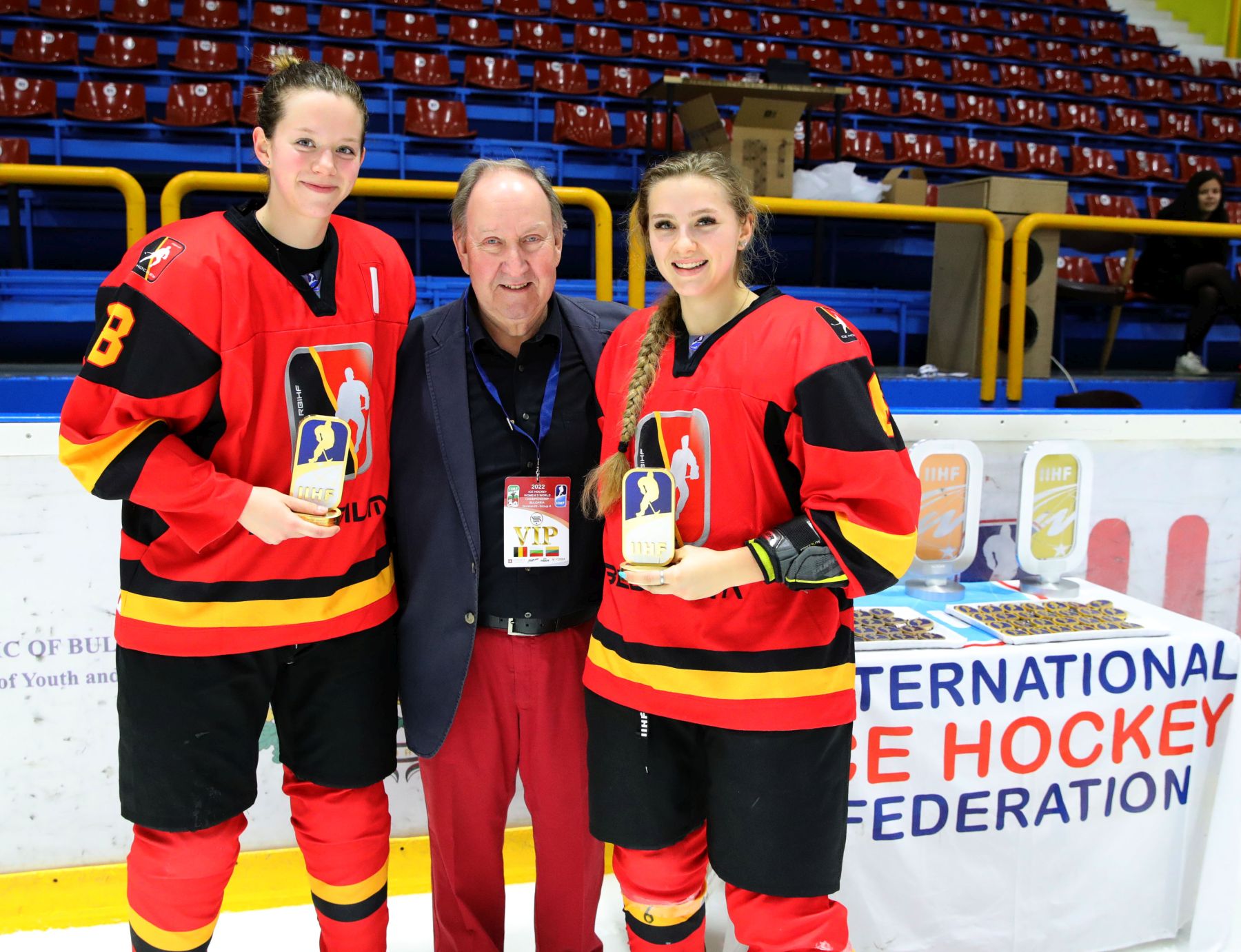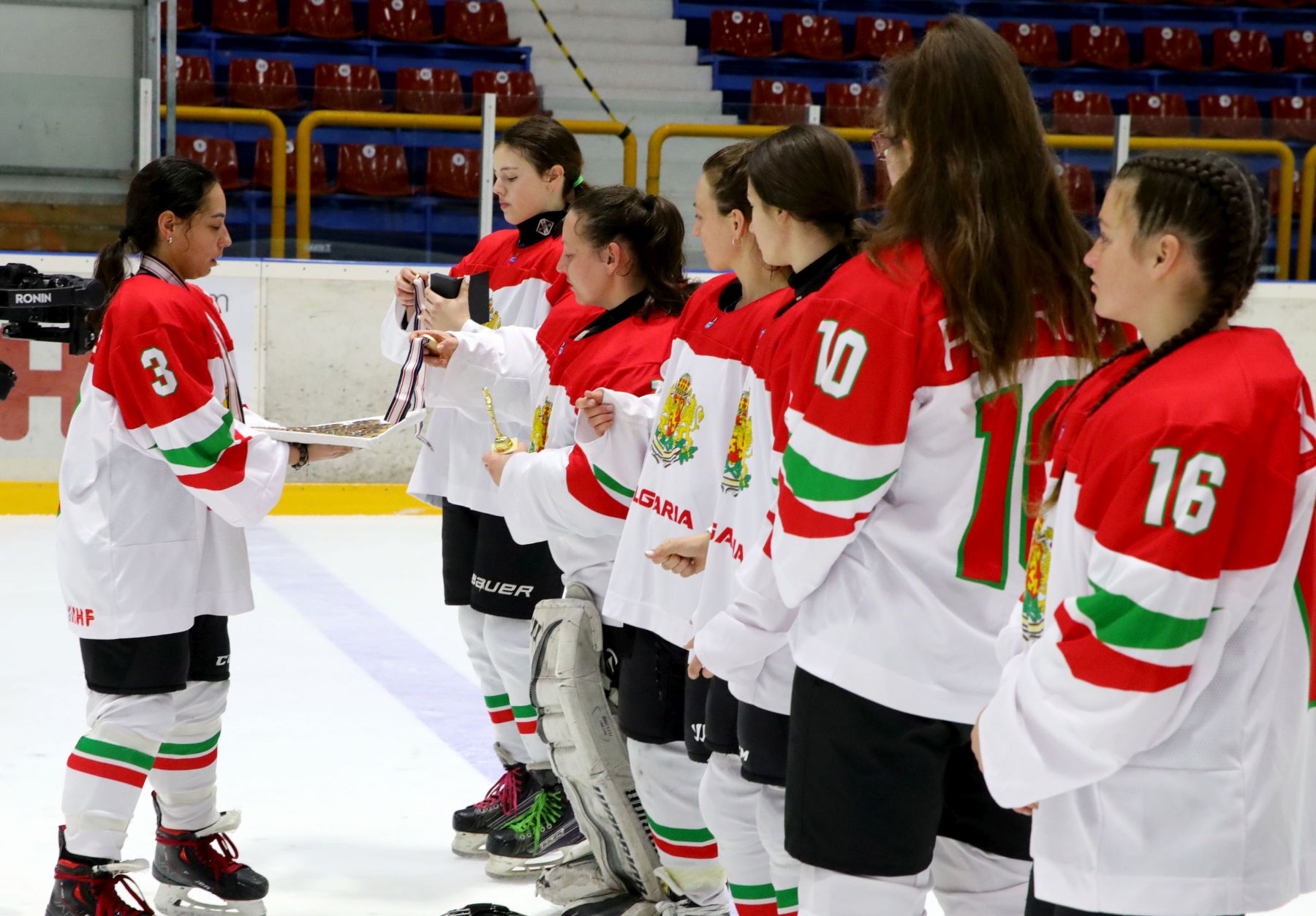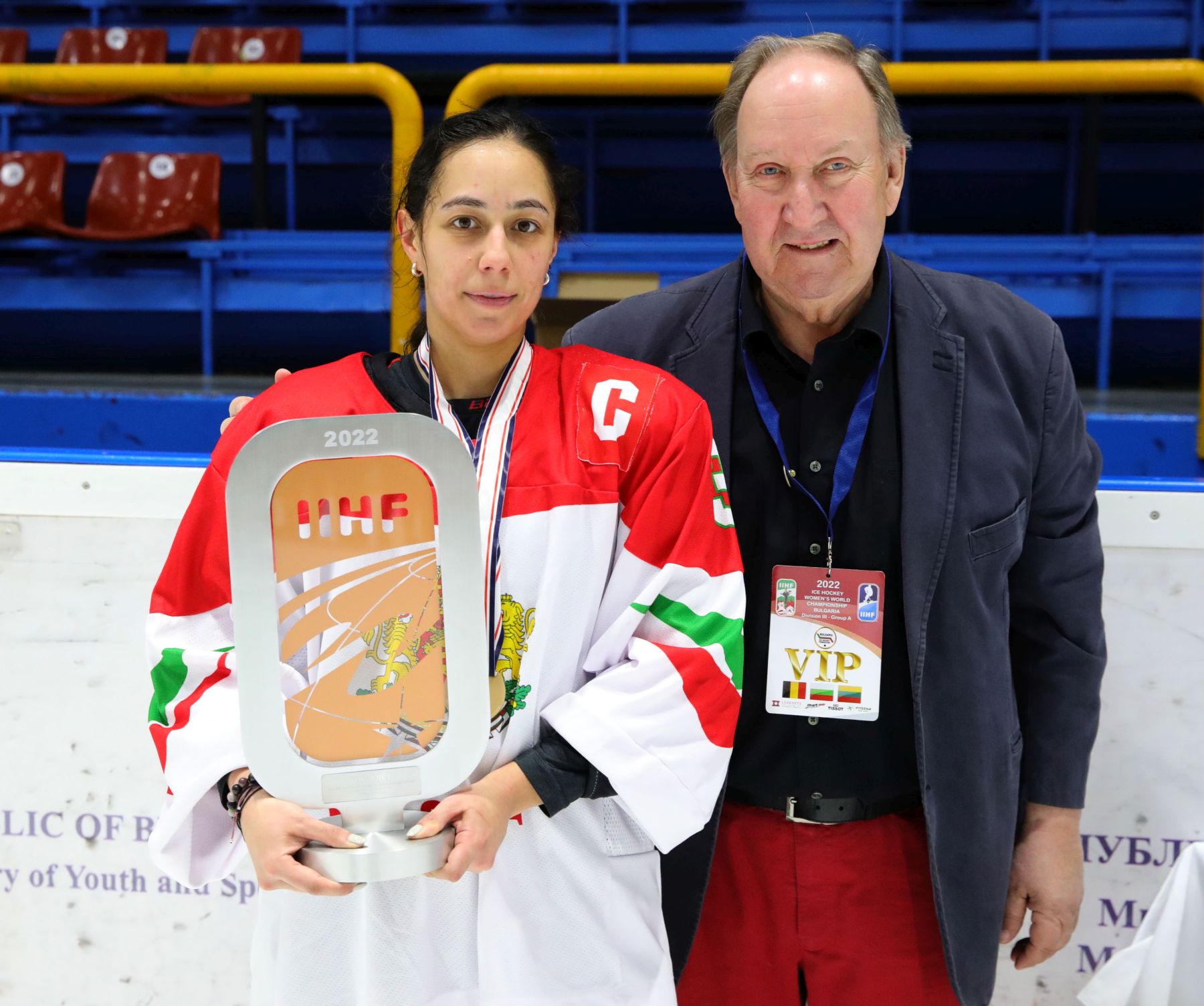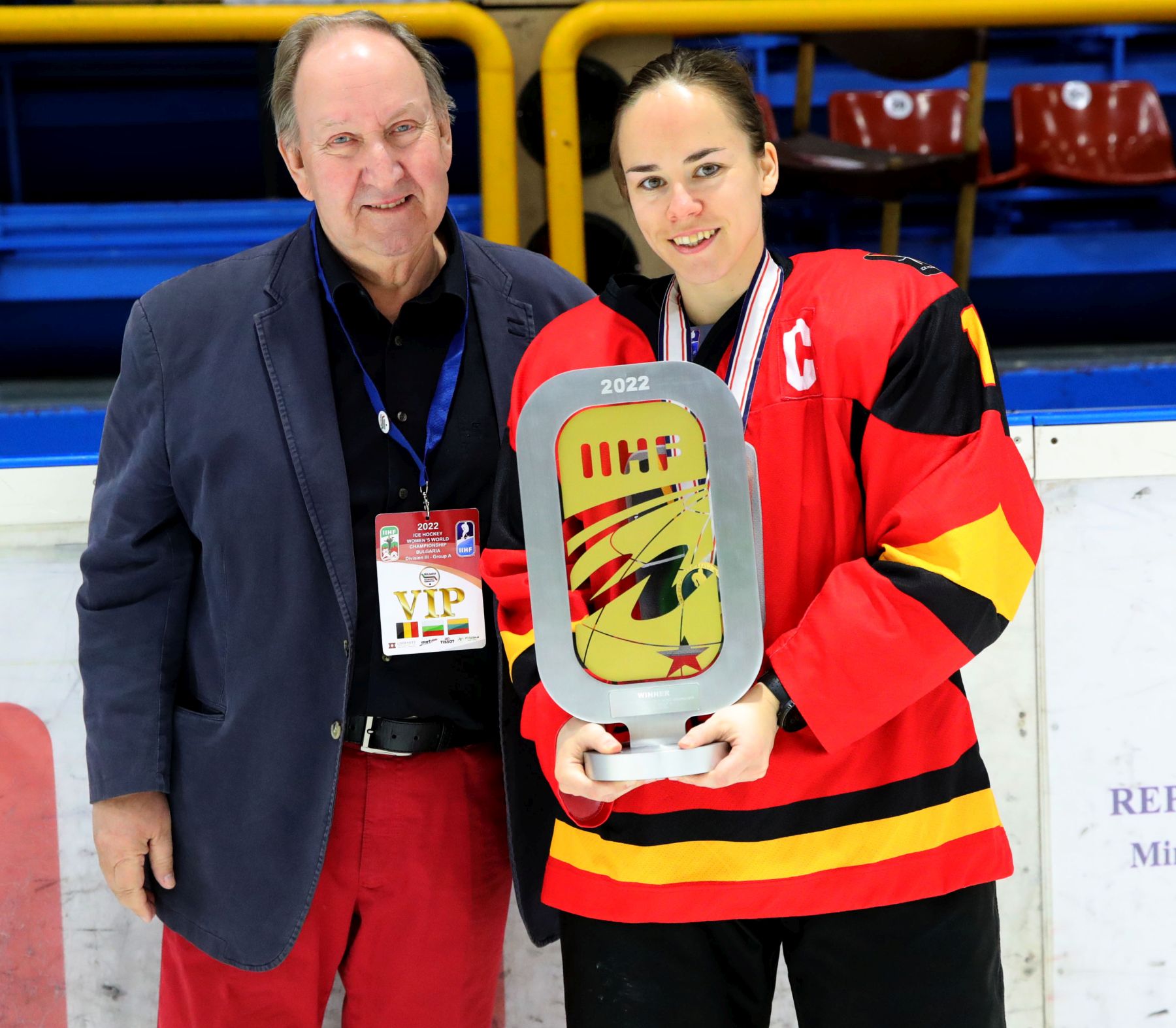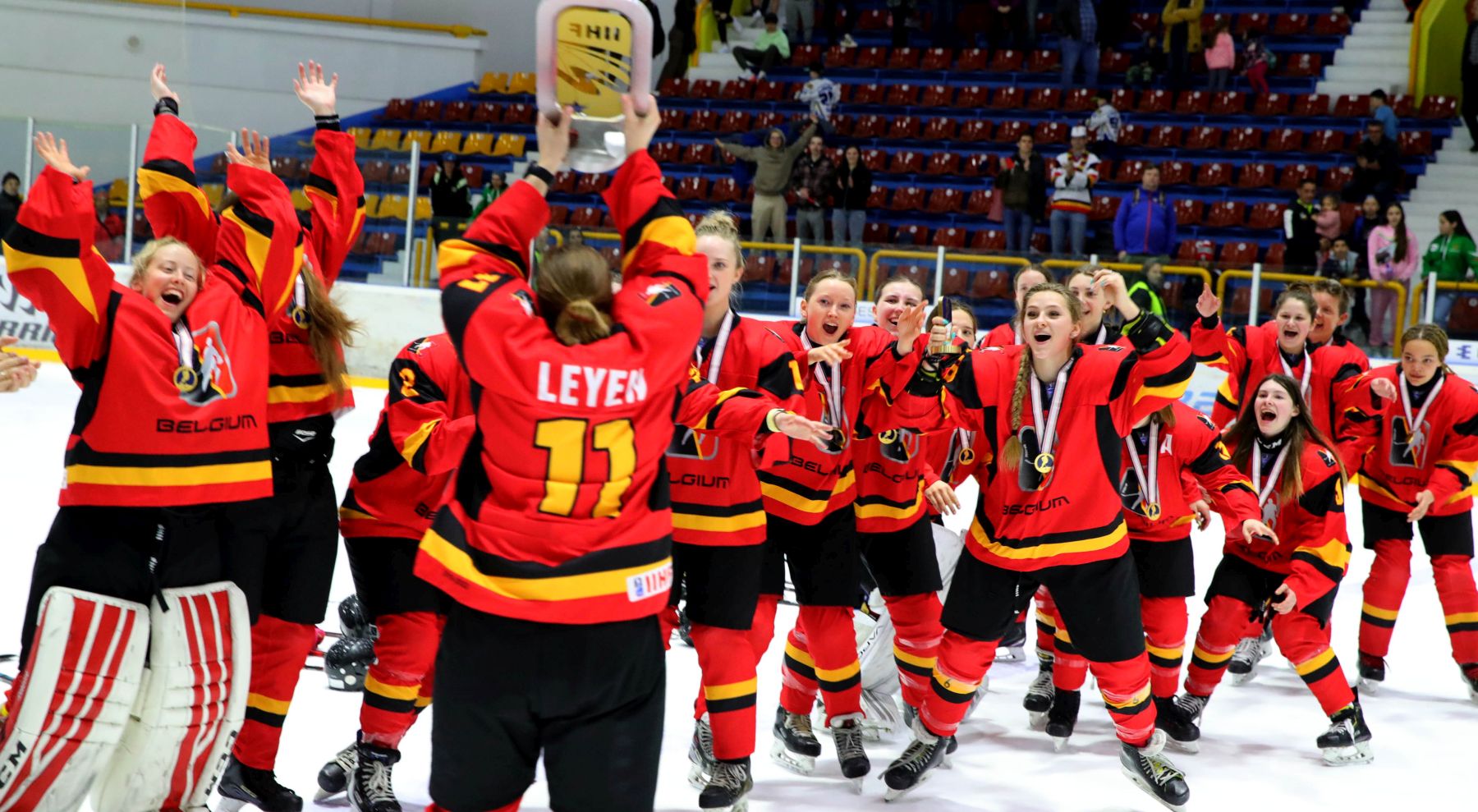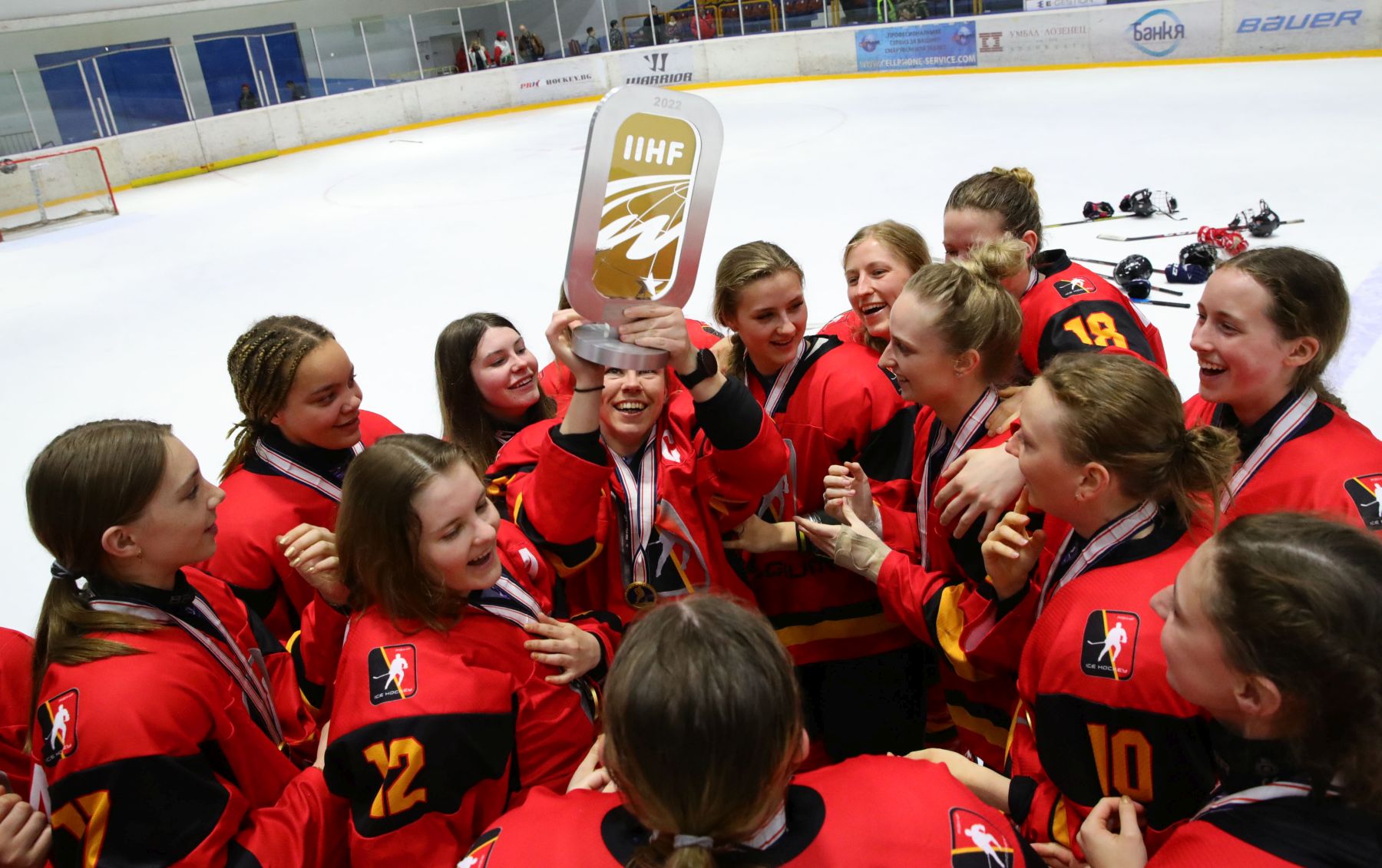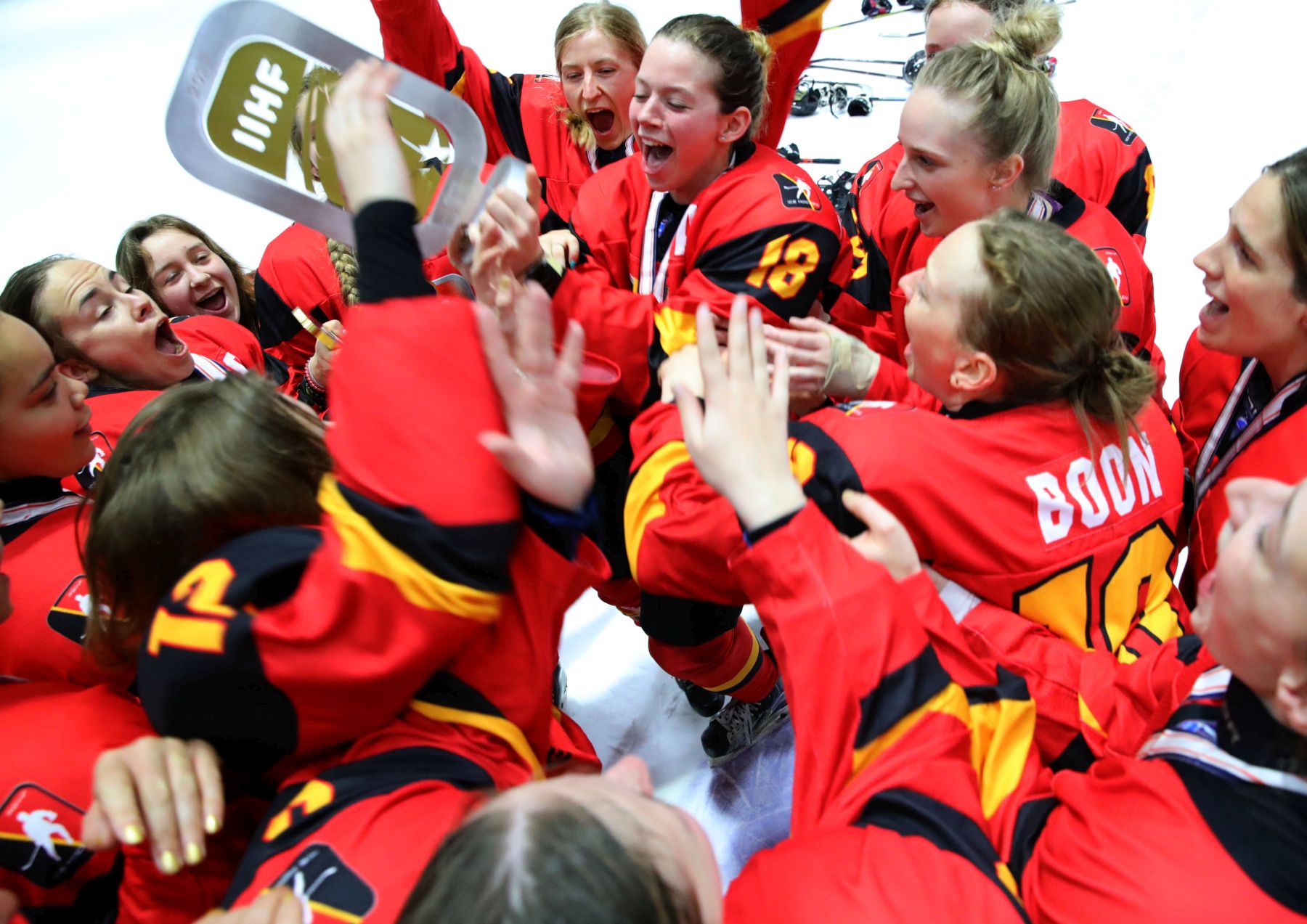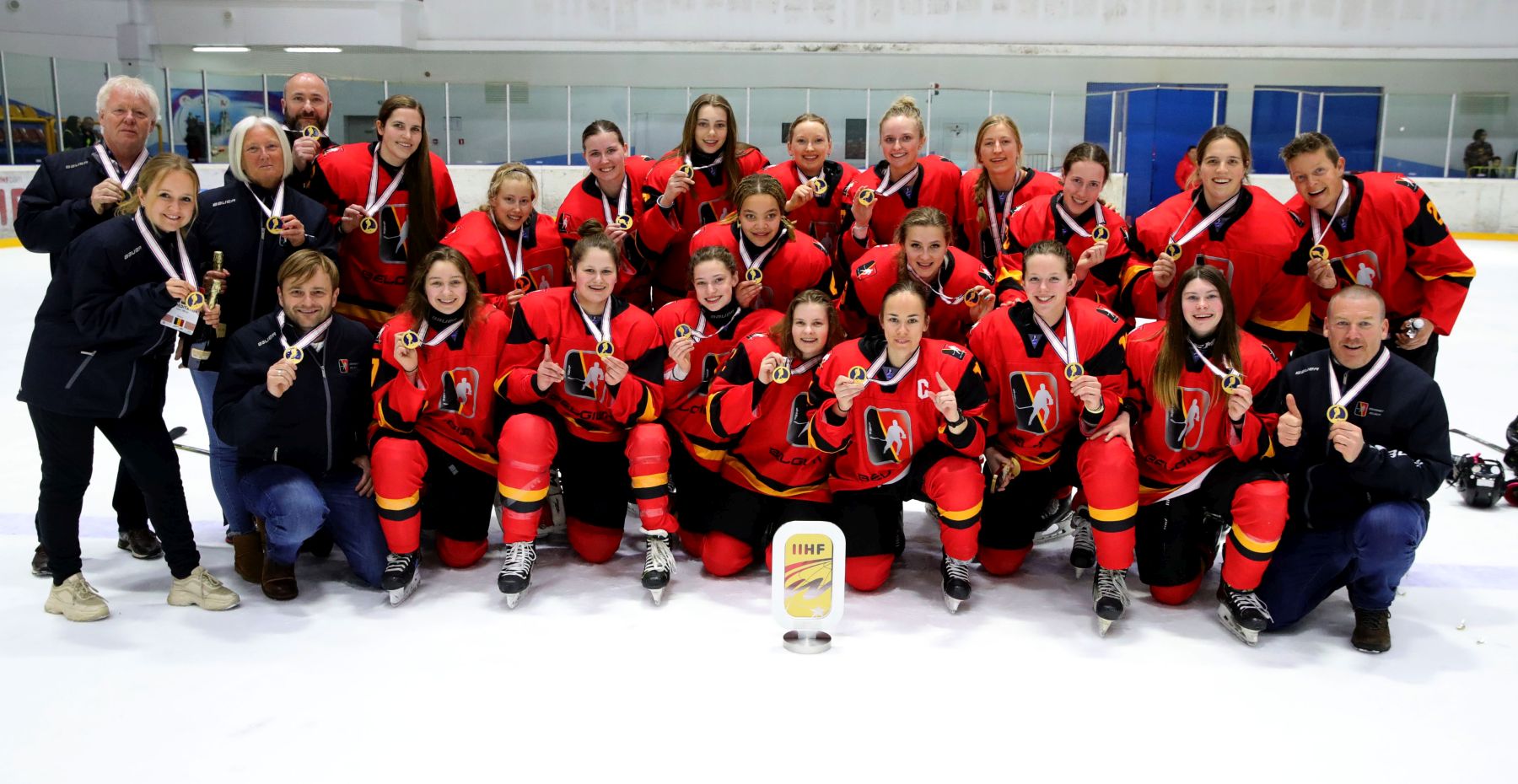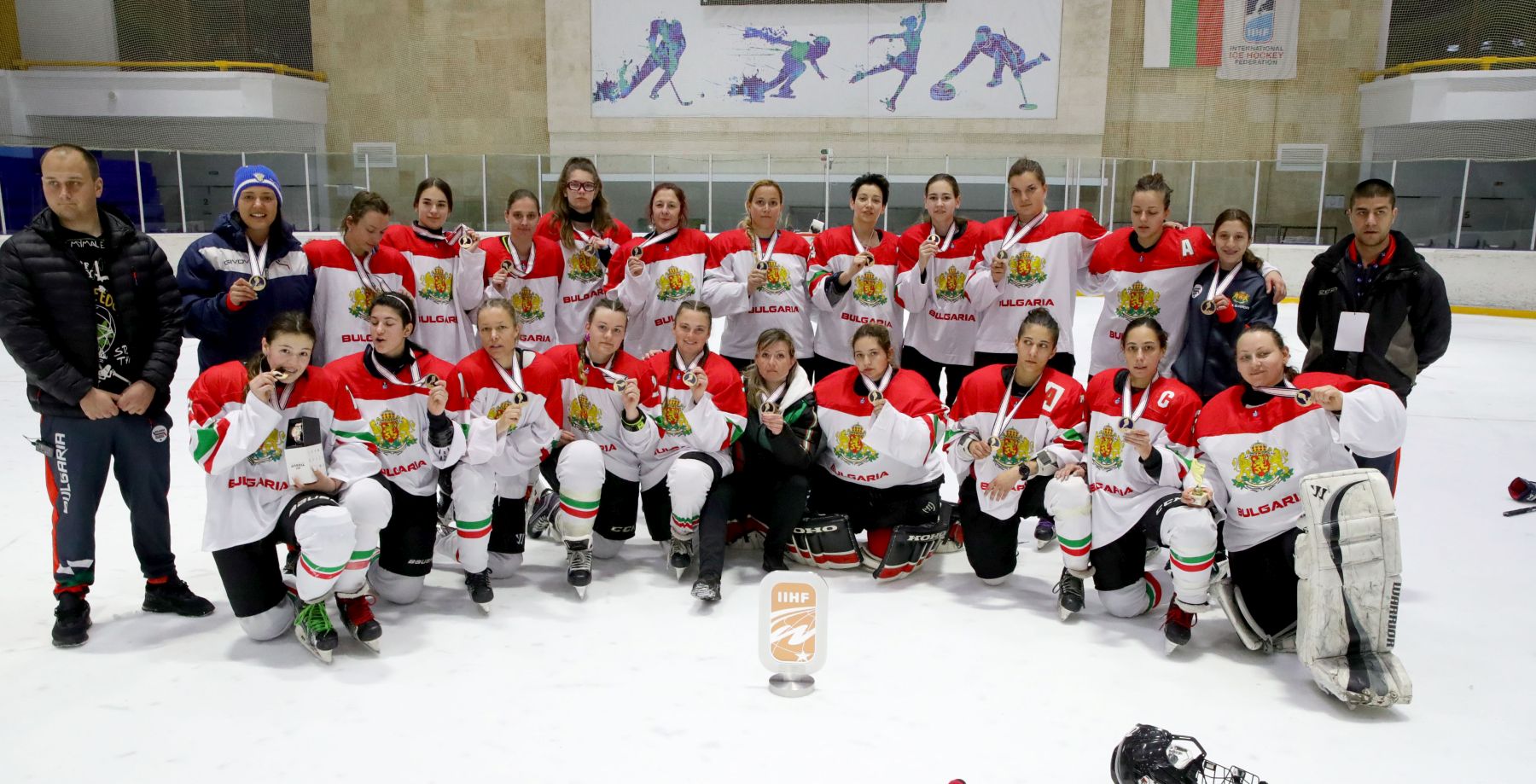Anke Steeno and Maria Runevska pose with their medals at the 2022 IIHF Ice Hockey Women’s World Championship Division III Group A.
photo: Bonchuk Andonov
Ice hockey tournaments in a 3-on-3 format with mixed nations teams for each gender made their debut at the 2020 Winter Youth Olympic Games, held from 10 to 15 January 2020 in Lausanne, Switzerland.
Soon after that the Covid-19 pandemic started and changed the whole world and the sports calendar in particular. Two players from the event met again 815 days later in the Winter Sports Palace in Sofia, Bulgaria during the recent 2022 IIHF Ice Hockey Women’s World Championship Division III Group A.
Anke Steeno from Belgium was part of Team Yellow that won the girls’ 3-on-3 tournament in Lausanne. Maria Runevska from Bulgaria was on Team Blue that finished with the bronze medals. They played two times against each other in the event with two wins for Team Yellow – 8-5 in the preliminary round (the only loss in regulation time for Team Blue) and 7-5 in the semi-finals two days later. In Sofia, Steeno and Runevska, both 16 years old, made their debuts for their women’s senior national teams and once again they finished with gold and bronze, respectively. It was their first international experience after the Winter Youth Olympics.
“I really love this format, 3-on-3. Everybody plays together, it is really hard, but a lot of fun to play. Ice hockey in Belgium is a really small sport, so it was nice to participate in an event like this and to be on the biggest stage. I’m still in contact with the girls from my team,” recalls Steeno. She hasn’t played a 3-on-3 tournament since and the same applies for Runevska: “After that I played 3-on-3 only in practices. I think it’s a very good format and I would be happy if there was a 3-on-3 tournament in the Olympics as well. It is something different, non-standard, but hard and challenging. The surface is small and with two, three strides you’re in front of the opponent’s net and you have to think much faster.”
Mimi, as Maria Runevska is known in Bulgaria, remembers Steeno well from the Youth Olympics experience: “She was out on the ice every time when I had a shift. We had few collisions, of course I remember her. I didn’t know that she would play here in Sofia, but saw a familiar face and recognized her. This time around I was the more aggressive one in the collisions. She has a tattoo with Olympic symbols and I told her that I wanted to have similar. She said: ‘That’s great, we will have identical tattoos.’”
Steeno and Runevska were the only representatives of their countries in the girls’ tournament in Lausanne. 43 countries participated in the mixed events (35 in the girls’) and 35 won medals (26).
“It was good promotion for Belgium’s women hockey. It was nice for them to experience that adventure and to play with better players,” said Tim Vos, head coach of Belgium at the Women’s World Championship Division III Group A in Sofia.
“It was not such a big thing that I won a gold, but it was on TV. Usually there is no TV exposure for hockey in Belgium. I had few interviews, photo sessions and etc. The aftereffect was more practices for women’s hockey,” Steeno remembers.
Steeno had a great tournament in Sofia too. She was chosen as the best player for Belgium in the first game against Lithuania and finished the event in third place overall for goals and assists and fourth in points with 11 (6+5). Steeno was tied third in plus-minus with +12, had 30 shots on net and scored at least a goal in every game with a hattrick in the last one against Bulgaria, when she had many shifts against Runevska again.
“Anke is a worker, still very young and playful. If you coach her well, she will do what you say, she will keep going forward. She is quite good at puck recapturing. If she loses the puck, she is right away back at it. That’s a good quality. She has to work more on her strength, but the rest will come,” said Coach Vos.
“I didn’t have any expectations for this tournament. Didn’t expect to play so much and to play on the first line. I am very happy with the results. I am proud to be on this team and to call it my team. I also want to thank the coaches. They believed in me and I got great chances to show what I can do. The whole team did a wonderful job,” said 2005-born Steeno.
Runevska was selected as Bulgaria’s best player for the second game against Lithuania and for the whole tournament. She scored a goal, had an assist and 17 shots on net.
“She didn’t flinch under pressure, despite her age and lack of experience. Mimi showed her character and qualities, she gave all of herself and our coaching staff decided to reward her as the best player on the team,” said Krasimir Monov, Bulgaria’s head coach.
“I am very happy with my performance and I think I deserved it, because I trained very hard in this tough period. Even when we were locked at home, I was out with my dog doing crosses. At home I dribbled a lot and was doing exercises,” explained Runevska, also born in 2005. “The first game, playing for Bulgaria, I was worried. The first shift my heart was pumping high, but then I started to calm down. There were great expectations on my shoulders. I think we played our best in the third game, but we couldn’t realize our chances. That is our biggest problem.”
For Steeno and Runevska the tournament in Sofia was the next step in their development, but а completely different experience. “There was a lot of tension. I am exhausted both physically and mentally. It was much different at the Youth Olympics. We had games there, events for fun and the teammates were not critical at all. Here I was very well accepted from the girls too, but it was quite a workload with four games in six days and to give as much as you can every time on ice,” said Runevska.
“It was wonderful to play on a world stage again after this difficult period. It was really hard time during the Covid-19 pandemic. We didn’t train for a long time and a lot of games from our championship were cancelled, but this season we were able to train together every Monday and that was great,” said Steeno, who broke a collarbone in December in a game of the U19 Belgian boy’s league. “It was an open wound and I had a surgery. I was out for three months. I couldn’t do anything and it was very hard period. I watched the games of the boys and the girls and it was devastating to be on the stands and not on the ice.”
There are many challenges during the girls’ hockey development, but the stage after turning 16 years old is quite tough, because of restrictions to play in boys’ leagues in some countries and even if you can play - the rules are different and the physical contact is with greater danger. The other option usually is to go to another country with women’s hockey on a higher level. Steeno and Runevska plan to stay home though.
“It is possible to leave to get better development, but I am not sure at the moment. Right now, the things are going very well in Belgium – training a lot with different teams, playing different leagues, learning a lot from this experience. There is no need to leave for now,” explained Steeno.
“We need more ice time to develop. Hockey is fast changing sport and we need to be in synch with adequate drills. Even when there are not so many girls at one practice, there are useful exercises to use. As a women’s national team, it would be great for us to have games with U16 boys’ teams,” said Runevska, who won a gold medal with Slavia Sofia in the U16 Bulgarian league. “At this World Championship I had difficult moments to control myself, because I am taught and used to play with bodychecks. I have one more year in U16. I would like to play U18 too, as many girls in other countries do, but the rules here do not allow me. However, the boys gave me one of their gold medals in the U18, because at Slavia we are one big hockey family,” said Runevska.
Soon after that the Covid-19 pandemic started and changed the whole world and the sports calendar in particular. Two players from the event met again 815 days later in the Winter Sports Palace in Sofia, Bulgaria during the recent 2022 IIHF Ice Hockey Women’s World Championship Division III Group A.
Anke Steeno from Belgium was part of Team Yellow that won the girls’ 3-on-3 tournament in Lausanne. Maria Runevska from Bulgaria was on Team Blue that finished with the bronze medals. They played two times against each other in the event with two wins for Team Yellow – 8-5 in the preliminary round (the only loss in regulation time for Team Blue) and 7-5 in the semi-finals two days later. In Sofia, Steeno and Runevska, both 16 years old, made their debuts for their women’s senior national teams and once again they finished with gold and bronze, respectively. It was their first international experience after the Winter Youth Olympics.
“I really love this format, 3-on-3. Everybody plays together, it is really hard, but a lot of fun to play. Ice hockey in Belgium is a really small sport, so it was nice to participate in an event like this and to be on the biggest stage. I’m still in contact with the girls from my team,” recalls Steeno. She hasn’t played a 3-on-3 tournament since and the same applies for Runevska: “After that I played 3-on-3 only in practices. I think it’s a very good format and I would be happy if there was a 3-on-3 tournament in the Olympics as well. It is something different, non-standard, but hard and challenging. The surface is small and with two, three strides you’re in front of the opponent’s net and you have to think much faster.”
Mimi, as Maria Runevska is known in Bulgaria, remembers Steeno well from the Youth Olympics experience: “She was out on the ice every time when I had a shift. We had few collisions, of course I remember her. I didn’t know that she would play here in Sofia, but saw a familiar face and recognized her. This time around I was the more aggressive one in the collisions. She has a tattoo with Olympic symbols and I told her that I wanted to have similar. She said: ‘That’s great, we will have identical tattoos.’”
Steeno and Runevska were the only representatives of their countries in the girls’ tournament in Lausanne. 43 countries participated in the mixed events (35 in the girls’) and 35 won medals (26).
“It was good promotion for Belgium’s women hockey. It was nice for them to experience that adventure and to play with better players,” said Tim Vos, head coach of Belgium at the Women’s World Championship Division III Group A in Sofia.
“It was not such a big thing that I won a gold, but it was on TV. Usually there is no TV exposure for hockey in Belgium. I had few interviews, photo sessions and etc. The aftereffect was more practices for women’s hockey,” Steeno remembers.
Steeno had a great tournament in Sofia too. She was chosen as the best player for Belgium in the first game against Lithuania and finished the event in third place overall for goals and assists and fourth in points with 11 (6+5). Steeno was tied third in plus-minus with +12, had 30 shots on net and scored at least a goal in every game with a hattrick in the last one against Bulgaria, when she had many shifts against Runevska again.
“Anke is a worker, still very young and playful. If you coach her well, she will do what you say, she will keep going forward. She is quite good at puck recapturing. If she loses the puck, she is right away back at it. That’s a good quality. She has to work more on her strength, but the rest will come,” said Coach Vos.
“I didn’t have any expectations for this tournament. Didn’t expect to play so much and to play on the first line. I am very happy with the results. I am proud to be on this team and to call it my team. I also want to thank the coaches. They believed in me and I got great chances to show what I can do. The whole team did a wonderful job,” said 2005-born Steeno.
Runevska was selected as Bulgaria’s best player for the second game against Lithuania and for the whole tournament. She scored a goal, had an assist and 17 shots on net.
“She didn’t flinch under pressure, despite her age and lack of experience. Mimi showed her character and qualities, she gave all of herself and our coaching staff decided to reward her as the best player on the team,” said Krasimir Monov, Bulgaria’s head coach.
“I am very happy with my performance and I think I deserved it, because I trained very hard in this tough period. Even when we were locked at home, I was out with my dog doing crosses. At home I dribbled a lot and was doing exercises,” explained Runevska, also born in 2005. “The first game, playing for Bulgaria, I was worried. The first shift my heart was pumping high, but then I started to calm down. There were great expectations on my shoulders. I think we played our best in the third game, but we couldn’t realize our chances. That is our biggest problem.”
For Steeno and Runevska the tournament in Sofia was the next step in their development, but а completely different experience. “There was a lot of tension. I am exhausted both physically and mentally. It was much different at the Youth Olympics. We had games there, events for fun and the teammates were not critical at all. Here I was very well accepted from the girls too, but it was quite a workload with four games in six days and to give as much as you can every time on ice,” said Runevska.
“It was wonderful to play on a world stage again after this difficult period. It was really hard time during the Covid-19 pandemic. We didn’t train for a long time and a lot of games from our championship were cancelled, but this season we were able to train together every Monday and that was great,” said Steeno, who broke a collarbone in December in a game of the U19 Belgian boy’s league. “It was an open wound and I had a surgery. I was out for three months. I couldn’t do anything and it was very hard period. I watched the games of the boys and the girls and it was devastating to be on the stands and not on the ice.”
There are many challenges during the girls’ hockey development, but the stage after turning 16 years old is quite tough, because of restrictions to play in boys’ leagues in some countries and even if you can play - the rules are different and the physical contact is with greater danger. The other option usually is to go to another country with women’s hockey on a higher level. Steeno and Runevska plan to stay home though.
“It is possible to leave to get better development, but I am not sure at the moment. Right now, the things are going very well in Belgium – training a lot with different teams, playing different leagues, learning a lot from this experience. There is no need to leave for now,” explained Steeno.
“We need more ice time to develop. Hockey is fast changing sport and we need to be in synch with adequate drills. Even when there are not so many girls at one practice, there are useful exercises to use. As a women’s national team, it would be great for us to have games with U16 boys’ teams,” said Runevska, who won a gold medal with Slavia Sofia in the U16 Bulgarian league. “At this World Championship I had difficult moments to control myself, because I am taught and used to play with bodychecks. I have one more year in U16. I would like to play U18 too, as many girls in other countries do, but the rules here do not allow me. However, the boys gave me one of their gold medals in the U18, because at Slavia we are one big hockey family,” said Runevska.
2022 IIHF Ice hockey Women's World Championship Division III Group A
OF




